Cisco Automotive Service [Column_Cisco Townsite]
 : Cisco, UT Sep. 11, 2014
: Cisco, UT Sep. 11, 2014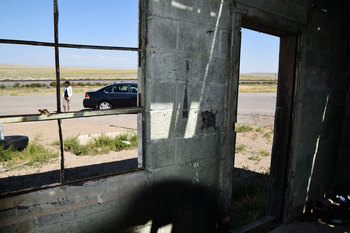 : Cisco, UT Sep. 11, 2014
: Cisco, UT Sep. 11, 2014I’m trying to duplicate the whole town of Cisco, Utah in N scale. This post introduces one of the structures in the town.
A few businesses survived along US Hwy 50 & 6 at Cisco in the early 70s; 4 gas service stations, a mercantile/cafe, and a motel. Some private houses also seem to exist along Second Street. The easternmost of the town sat this structure on Lots 1, 2, and 3 of Block 1, Cisco Townsite.
Elton Richard "Buddy"(1906 – 1981) and Mary Aeline Lewis(1919 – 2016) Cowger established the Cisco Automotive Service in 1950[1]. Buddy managed to ride both wheelchair and tow truck to carry out his business[2]. Two 500-gallon underground steel tanks provided the gasoline. But they sold the property and moved to Grand Junction, CO in 1953[1].
Raymond "Ray" (1908 – 1989) and Althea M. Goutierrez (1910 – 1962) Scott succeeded the business in 1955[3, 4]. After the demise of Althea, her sister Mable Goutierrez("Mabel" 1909 – ?) helped Ray run the station[5]. Unfortunately, however, Ray closed the business by 1976 and moved to Reno, NV[6]. The property was offered for sale at a public auction in 1978[7].
After a while, in 1984, Gary M Bizer(1947 – ) of Palisade, CO painted the mural for Larry Lee Sheets(1943 – 1999) who was doing business here as the White Buffalo Trading Post[8]. The remains of the mural can still be seen on the walls.
In 1998, the landscape painter Don Stinson of Denver and the other three artists filled the by-then vacant structure with art as a Collaborative Installation East/West Passage and it was introduced in the newspaper New York Times[9, 10].
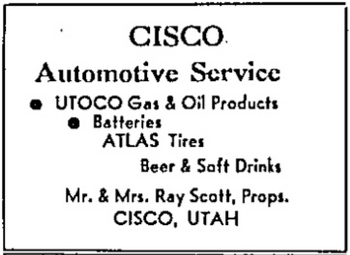 : Sep. 29, 1955 Times Independent
: Sep. 29, 1955 Times Independent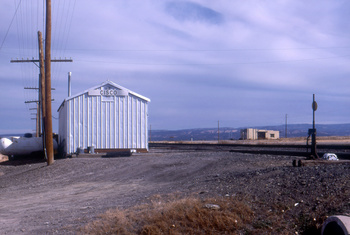 : Nov. 1, 1988 photo by Jim Ozment
: Nov. 1, 1988 photo by Jim OzmentThe structure of Cisco Automotive Service built in 1950 still existed as of 2014, but in a miserable appearance, as you can see in the photos above. However, fortunately, the structure was mainly made of cinderblocks, I could count the joints on the wall in the photos to infer the dimensions to draw plans of the structure.
Aerial photos from Google Maps also helped me drawing plans. Former Rio Grande tracks on the opposite side of the road brought me the approximate scale. The result of my survey is shown below as plans: of course, some imaginations (for example, missing door styles) are included.
revised Sep. 22, 2014
revised Dec. 22, 2014
revised Feb. 4, 2015
revised Jul. 27, 2016
revised Dec. 27, 2016
revised Feb. 16, 2018
revised Mar. 30, 2019
revised Nov. 11, 2019
revised Apr. 4, 2021
revised, Aug. 3, 2021
revised, Oct. 14, 2022
revised Apr. 14, 2023
[1] Hepperle, Mary L. Cowger, (2004) "Memories of Cisco", Canyon Legacy, Vol. 51, Moab Museum;
[2] Ringholz, Raye C., (2002) Uranium frenzy, Utah State University Press;
[3] Sep. 29, 1955 Times Independent;
[4] Jul. 12, 1962 Times Independent;
[5] Miller, Patti "Comment for 'The Streets of Cisco, Utah'", Ghost Town: Cisco, Utah;
[6] Apr. 1, 1976 Times Independent;
[7] Apr. 27, 1978 Times Independent;
[8] Sep. 14, 1984 Daily Sentinel;
[9] Stinson, Don, Chronology;
[10] Brook, Heilman, Elizabeth, (2000) Arts in America; Home of the Range, With Drive-Ins and Gas Stations, Jan. 26, 2000 New York Times;
 : North elevation
: North elevation : East elevation
: East elevation2013-05-03 09:00
コメント(0)
Duke's Service [Column_Cisco Townsite]
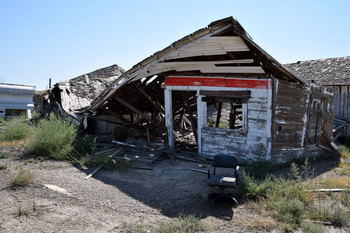 : Cisco, UT. Sep. 11, 2014
: Cisco, UT. Sep. 11, 2014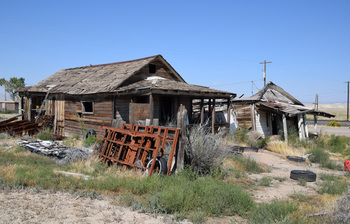 : Cisco, UT. Sep. 11, 2014
: Cisco, UT. Sep. 11, 2014I’m trying to duplicate the whole town of Cisco, Utah in N scale. This post introduces one of the structures in the town.
A few businesses survived along US Hwy 50 & 6 at Cisco in the early 70s; 4 gas service stations, a mercantile/cafe, and a motel. Some private houses also seem to exist along Second Street. Next to Cisco Automotive Service on the west sat this structure on Block 2, Cisco Townsite.
The 1971 movie Vanishing Point barely shows this structure hanging out Phillips 66 sign. In the movie, this structure painted white with a red band is hardly seen. This structure also appears in the 1990 movie Thelma and Louise as a tired service station/beauty salon.
Several historical documents describing this structure are found: Kathy Jordan describes this structure as the Capansky’s Bar, Restaurant and Conoco Gas Station[1]. Mary L. Cowger Hepperle describes this structure as the Capansky's Cafe Beer Joint[2]. A 1957 Legal Notice designated it as Mrs. Capansky's Cafe[3]. And, the 1961 Annual Financial Report of Grand County lists it as Duke's Service[4].
William Boston "Bill"(1887 ー 1951) and Eppie Nettice Fanning(1890 ー 1976) Capansky arrived at Cisco in 1925[5]. Bill and Eppie established the garage built with railroad ties by 1927[6, 7].
In 1934, Bill opened up the gas service station in the former Pace Brothers Company building next to his garage[8]. Pace Brothers Company was a stock and ranch holding company established in 1913 and acquired the Cisco Mercantile Company in 1925. Remains of the particular service station is the structure shown in the photos above.
In 1936, the station was operated by Marmaduke Burnadette Woods(1910 ー 1971) as Duke's Station which appears in the 1955 advertisement shown below[9].
After the demise of Bill in 1951, Eppie transferred the Duke's business to Richard T. Bevins of Gunnison, CO[10]. By 1960, the gas supplier was changed from Texaco to Phillips as shown below. In 1969, it was operated by John William "Peg Leg Johnny"(1907 ー 1975) and Gertrude Irene(1906 ー 1994) Moore[5].
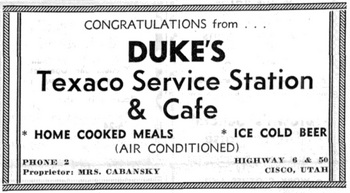 : July 21, 1955 Green River Journal
: July 21, 1955 Green River Journal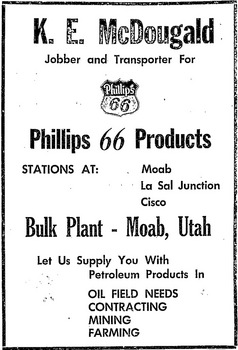 : June 29, 1960 Times Independent
: June 29, 1960 Times IndependentIn 1970, Eppie's son Robert Theodore "Ted"(1920 ー 2006) and Johney Ruth Driver(1923 ー 1978) Capansky came back from California to take care of their mother's holdings including a home and a place of business at Cisco[11]. Beer license was approved for Ted in 1971[12].
Unfortunately, however, the Annual Financial Statement For the Year Ended December 31, 1972 is the latest evidence of the survival of Ted's business to this day[13]. Even so, 2015 Grand County Tax Delinquent List still has Ted's name on it[14].
The structure of Duke's Service still existed as of 2014, but in a rather swayed appearance as you can see in the photos above. It took some time to figure out the shape of the chopped corner because of the structure’s distortion.
Its chopped corner entrance must be a later modification. The annex next to this structure on the south was moved from Green River, Utah[15].
The aerial photo of Google Maps helped me to infer the dimensions to draw plans. Former Rio Grande tracks on the opposite side of the road brought me the approximate scale. The result of my survey is shown below as drawings: of course, some imaginations are included.
revised Sep. 22, 2014
revised Jan. 7, 2015
revised Feb. 4, 2015
revised Dec. 28, 2016
revised Jan. 8, 2017
revised feb. 16, 2018
revised Jul. 24, 2021
revised, Sep. 23, 2022
revised, Apr. 14, 2023
[1] Jordan, Kathy. "‘Uranium King’ Charlie Steen started out in Cisco tarpaper shack", Mar. 24, 2011 Grand Junction Daily Sentinel;
[2] Hepperle, Mary L. Cowger. "Memories of Cisco", Canyon Legacy, Vol. 51, Moab Museum, 2004;
[3] Jan. 3, 1957 Times Independent;
[4] Oct. 5, 1961 Times Independent;
[5] Jul. 27, 1969 Daily Sentinel;
[6] Jul. 21, 1927 Times Independent;
[7] April 5, 1951 Times Independent;
[8] Dec. 13, 1934 Times Independent;
[9] Jun. 18, 1936 Times Independent;
[10] Nov. 15, 1951 Times Independent;
[11] Mar 19, 1970 Times Independent;
[12] Apr. 22, 1971 Times Independent;
[13] Mar. 1, 1973 Times Independent;
[14] 2015 Grand County Tax Delinquent List;
[15] Apr. 2, 1970 Times Independent;
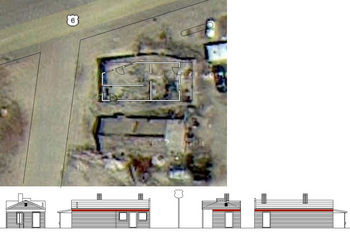 : Duke's Service drawings
: Duke's Service drawings : North and West elevation
: North and West elevation2013-05-24 09:00
コメント(0)
Ruth 66 Cafe [Column_Cisco Townsite]
: estimated site of Ruth 66 Cafe
I’m trying to duplicate the whole town of Cisco, Utah in N scale. This post introduces one of the structures in the town.
A few businesses survived along US Hwy 50 & 6 at Cisco in the early 70s; 4 gas service stations, a mercantile/cafe, and a motel. Some private houses also seem to exist along Second Street. Next to Duke's Service on the west sat this structure on Lot 1 to 5 of Block 6, Cisco Townsite.
The 1944 aerial photo provided by the U.S. Geological Survey barely shows the particular structure. 1974 USGS photo shows the structure still standing at the site on US Hwy 50 & 6.
The particular structure appears in the 1971 movie Vanishing Point as a vacant space[1]. The “RUTH’S 66 CAFE, OPEN 24 HOURS” sign left on the facade can also be seen in the movie.
In the book Helldorados, Ghosts and Camps of the Old Southwest, both the closed storefront and the west elevation of the structure are seen[2].
Block 6 of Cisco Townsite, consisted of 21 lots, was the "downtown" of Cisco. The Block one-time contained a hotel, a restaurant, a garage, a post office/store, and some dwellings according to 1919 ICC valuation map. The particular structure is shown as a restaurant and measures 25' x 43' in the map.
Victor Putman Hanson(1841 - 1920), who established the Cisco Townsite, Cisco Mercantile Company, and Cisco Hotel built a saloon next to his hotel in 1905[3].
Shideler family, William Andrew Shideler(1872 – 1939), his father Riley P. Shideler(1848 – 1921), and his son Lawrence A. Shideler(1901 – 1954), succeeded the hotel, saloon, garage, dwellings, and the post office in 1911 and operated them until 1921[4, 5]. The particular structure must have been Bill's Pool Room operated by Riley[6].
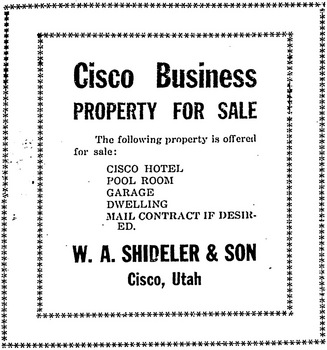 : Dec. 4, 1919 Times Independent
: Dec. 4, 1919 Times Independent
Patrick Franklin "Pat" Dyer(1861 – 1936) succeeded the business in 1922 and operated both the hotel and the pool hall until 1936[7, 8]. While Clive Charles Stewart(1899 – 1971) succeeded the pool hall after the demise of Pat, the hotel built by W. A. Shideler in 1917 was moved to Moab in 1940[9].
The structure was verified as Vic’s Cafe since 1944[10]. Victor Kirby Murray(1893 – 1962) owned the particular property in between 1944 and 1948[11]. Accordingly, Victor might have operated the Vic’s Cafe.
Brothers, John William(1898 – 1964) and Edgar Malcolm(1893 – 1954) Burke purchased all the Block 6 from Victor in 1948[12]. They opened up the Burke Cafe on Memorial Day−May 30, 1949[13].
The particular structure may have been Taylor Cafe at least in 1954 and 55, maybe operated by Robert Lloyd "Red"(1902 – 1969) and Della Larsen(1903 – 1984) Taylor[14, 15].
And then, here comes Ruth.
Jay Lowell "J."(1912 – 1968) and Ruth Maxine Craig(1918 – 1999) Mealey came to Cisco in 1956[16]. They started running the J&M STATION & CAFE, selling diesel, gas, oil, beer, and food.
The business was worth eighty-thousand dollars a year when they tried to sell the business in 1960 according to their advertisement in newspaper[17].
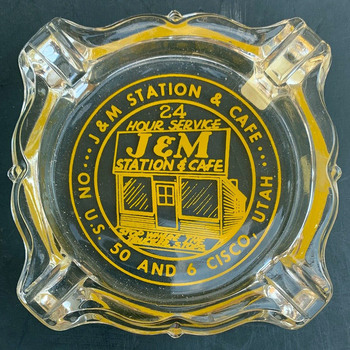 : ashtray
: ashtray
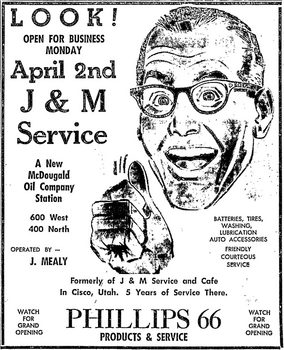 : Mar. 29, 1962 Times Independent
: Mar. 29, 1962 Times Independent
In 1961, Mealeys moved to Moab and began operating the Holiday Haven Mobile Home Resorts owned by a namesake company of Phoenix, Arizona[18]. Teddy D. "Ted"(1935 – 1961) and Jeannie Haeck(1938 – ?) Johnson succeeded the business[19]. Unfortunately, however, Ted died accidentally by electrocution touching live wire under their trailer house the same year[20].
Lloyd Frank(1918 – 1997) and Virginia Labrum(1923 – ?) Nelson, the owner of the Fruita Pool Hall, accepted all of Block 6 in 1963[21]. But whether they succeeded the business is uncertain.
And then, here comes another Ruth.
Ernest Eugene(1923 – 1989) and Ruth Lorene Endicott(1922 – 1986) McCoy of Moab seem bought all of Block 6 in 1963. Beer license was approved to Ernest of Cisco Cafe 66 same year[22].
Grand County Receipt and Disbursements Year Ended December 31, 1964 lists their business as Ruth 66 Cafe[23]. Melvin Jack Mills(1936 – 1973) might have been the operator in 1967[24]. Unfortunately, however, Ernest put all of Block 6 up for final tax sale in 1969[25].
I captured the movie Vanishing Point and traced the elevation to draw plans. The interior of the structure appeared in the movie also helped me. The result is shown below: of course, some imaginations are included.
[1] Ruth’s 66 Cafe still from the movie Vanishing Point at flickr;
[2] Weis, Norman D. Helldorados, Ghosts and Camps of the Old Southwest, Caxton Printers, 1977
[3] Apr. 14, 1905 Grand Valley Times;
[4] May 24, 1912 Times Independent;
[5] Dec. 4, 1919 Times Independent;
[6] Dec. 8, 1921 Times Independent;
[7] Nov. 23, 1922 Times Independent;
[8] Aug. 20, 1936 Times Independent;
[9] Feb. 11, 1937 Times Independent;
[10] Bennett, Lee A. A History of Selected Ranches on the Colorado River, Bennett Management Services, LLC, 2009;
[11] Hepperle, Mary L. "Memories of Cisco", Canyon Legacy, vol. 51, Moab Museum, 2004;
[12] Jan. 8, 1948 Times Independent;
[13] Jun. 8, 1949 Daily Sentinel;
[14] Dec. 9, 1954 Times Independent;
[15] Jan. 6, 1955 Times Independent;
[16] Feb. 20, 1999 Deseret News;
[17] Oct. 27, 1960 Times Independent;
[18] Nov. 12, 1964 Times Independent;
[19] May 18, 1961 Steamboat Pilot;
[20] May 4, 1961 Times Independent;
[21] May 23, 1963 Times Independent;
[22] Oct. 10, 1963 Times Independent;
[23] Apr. 8, 1965 Times Independent;
[24] Jun. 8, 1967 Times Independent;
[25] May 22, 1969 Times Independent;
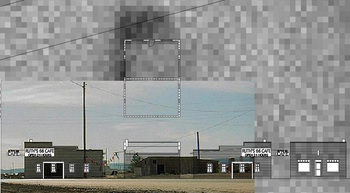 : references and drawings of Ruth 66 Cafe
: references and drawings of Ruth 66 Cafe
 : North and West elevation
: North and West elevation
I’m trying to duplicate the whole town of Cisco, Utah in N scale. This post introduces one of the structures in the town.
A few businesses survived along US Hwy 50 & 6 at Cisco in the early 70s; 4 gas service stations, a mercantile/cafe, and a motel. Some private houses also seem to exist along Second Street. Next to Duke's Service on the west sat this structure on Lot 1 to 5 of Block 6, Cisco Townsite.
The 1944 aerial photo provided by the U.S. Geological Survey barely shows the particular structure. 1974 USGS photo shows the structure still standing at the site on US Hwy 50 & 6.
The particular structure appears in the 1971 movie Vanishing Point as a vacant space[1]. The “RUTH’S 66 CAFE, OPEN 24 HOURS” sign left on the facade can also be seen in the movie.
In the book Helldorados, Ghosts and Camps of the Old Southwest, both the closed storefront and the west elevation of the structure are seen[2].
Block 6 of Cisco Townsite, consisted of 21 lots, was the "downtown" of Cisco. The Block one-time contained a hotel, a restaurant, a garage, a post office/store, and some dwellings according to 1919 ICC valuation map. The particular structure is shown as a restaurant and measures 25' x 43' in the map.
Victor Putman Hanson(1841 - 1920), who established the Cisco Townsite, Cisco Mercantile Company, and Cisco Hotel built a saloon next to his hotel in 1905[3].
Shideler family, William Andrew Shideler(1872 – 1939), his father Riley P. Shideler(1848 – 1921), and his son Lawrence A. Shideler(1901 – 1954), succeeded the hotel, saloon, garage, dwellings, and the post office in 1911 and operated them until 1921[4, 5]. The particular structure must have been Bill's Pool Room operated by Riley[6].
 : Dec. 4, 1919 Times Independent
: Dec. 4, 1919 Times IndependentPatrick Franklin "Pat" Dyer(1861 – 1936) succeeded the business in 1922 and operated both the hotel and the pool hall until 1936[7, 8]. While Clive Charles Stewart(1899 – 1971) succeeded the pool hall after the demise of Pat, the hotel built by W. A. Shideler in 1917 was moved to Moab in 1940[9].
The structure was verified as Vic’s Cafe since 1944[10]. Victor Kirby Murray(1893 – 1962) owned the particular property in between 1944 and 1948[11]. Accordingly, Victor might have operated the Vic’s Cafe.
Brothers, John William(1898 – 1964) and Edgar Malcolm(1893 – 1954) Burke purchased all the Block 6 from Victor in 1948[12]. They opened up the Burke Cafe on Memorial Day−May 30, 1949[13].
The particular structure may have been Taylor Cafe at least in 1954 and 55, maybe operated by Robert Lloyd "Red"(1902 – 1969) and Della Larsen(1903 – 1984) Taylor[14, 15].
And then, here comes Ruth.
Jay Lowell "J."(1912 – 1968) and Ruth Maxine Craig(1918 – 1999) Mealey came to Cisco in 1956[16]. They started running the J&M STATION & CAFE, selling diesel, gas, oil, beer, and food.
The business was worth eighty-thousand dollars a year when they tried to sell the business in 1960 according to their advertisement in newspaper[17].
 : ashtray
: ashtray : Mar. 29, 1962 Times Independent
: Mar. 29, 1962 Times IndependentIn 1961, Mealeys moved to Moab and began operating the Holiday Haven Mobile Home Resorts owned by a namesake company of Phoenix, Arizona[18]. Teddy D. "Ted"(1935 – 1961) and Jeannie Haeck(1938 – ?) Johnson succeeded the business[19]. Unfortunately, however, Ted died accidentally by electrocution touching live wire under their trailer house the same year[20].
Lloyd Frank(1918 – 1997) and Virginia Labrum(1923 – ?) Nelson, the owner of the Fruita Pool Hall, accepted all of Block 6 in 1963[21]. But whether they succeeded the business is uncertain.
And then, here comes another Ruth.
Ernest Eugene(1923 – 1989) and Ruth Lorene Endicott(1922 – 1986) McCoy of Moab seem bought all of Block 6 in 1963. Beer license was approved to Ernest of Cisco Cafe 66 same year[22].
Grand County Receipt and Disbursements Year Ended December 31, 1964 lists their business as Ruth 66 Cafe[23]. Melvin Jack Mills(1936 – 1973) might have been the operator in 1967[24]. Unfortunately, however, Ernest put all of Block 6 up for final tax sale in 1969[25].
I captured the movie Vanishing Point and traced the elevation to draw plans. The interior of the structure appeared in the movie also helped me. The result is shown below: of course, some imaginations are included.
revised Dec. 24, 2013
revised Sep. 22, 2014
revised Dec. 22, 2014
revised Jan. 9, 2015
revised Feb. 4, 2015
revised Jul. 30, 2015
revised Oct. 26, 2015
revised Nov. 10, 2015
revised Jul. 26, 2016
revised Aug. 23, 2016
revised Oct. 23, 2016
revised Dec. 28, 2016
revised Jan. 8, 2017
revised Jan. 30, 2017
revised Feb. 19, 2018
revised Oct. 14, 2020
revised Aug. 5, 2021
revised, Sep. 23, 2022
revised, Apr. 14, 2023
[1] Ruth’s 66 Cafe still from the movie Vanishing Point at flickr;
[2] Weis, Norman D. Helldorados, Ghosts and Camps of the Old Southwest, Caxton Printers, 1977
[3] Apr. 14, 1905 Grand Valley Times;
[4] May 24, 1912 Times Independent;
[5] Dec. 4, 1919 Times Independent;
[6] Dec. 8, 1921 Times Independent;
[7] Nov. 23, 1922 Times Independent;
[8] Aug. 20, 1936 Times Independent;
[9] Feb. 11, 1937 Times Independent;
[10] Bennett, Lee A. A History of Selected Ranches on the Colorado River, Bennett Management Services, LLC, 2009;
[11] Hepperle, Mary L. "Memories of Cisco", Canyon Legacy, vol. 51, Moab Museum, 2004;
[12] Jan. 8, 1948 Times Independent;
[13] Jun. 8, 1949 Daily Sentinel;
[14] Dec. 9, 1954 Times Independent;
[15] Jan. 6, 1955 Times Independent;
[16] Feb. 20, 1999 Deseret News;
[17] Oct. 27, 1960 Times Independent;
[18] Nov. 12, 1964 Times Independent;
[19] May 18, 1961 Steamboat Pilot;
[20] May 4, 1961 Times Independent;
[21] May 23, 1963 Times Independent;
[22] Oct. 10, 1963 Times Independent;
[23] Apr. 8, 1965 Times Independent;
[24] Jun. 8, 1967 Times Independent;
[25] May 22, 1969 Times Independent;
 : references and drawings of Ruth 66 Cafe
: references and drawings of Ruth 66 Cafe : North and West elevation
: North and West elevation2013-09-06 09:00
コメント(1)
Cisco Mercantile [Column_Cisco Townsite]
: site of Cisco Mercantile
I’m trying to duplicate the whole town of Cisco, Utah in N scale. This post introduces one of the structures in the town.
A few businesses survived along US Hwy 50 & 6 at Cisco in the early 70s; 4 gas service stations, a mercantile/cafe, and a motel. Some private houses also seem to exist along Second Street. Next to Ruth 66 Cafe on the west sat this structure on Lot 1 to 7 of Block 5, Cisco Townsite.
In the photo by John Barriger III taken no later than 1940, the west and north elevation of the structure are barely seen[1].
In the 1946 photo appeared in Canyon Legacy, a part of the south elevation of the structure is seen[2].
In the 1967 photo appeared in Gravity Base Station Network in Utah, the structure is barely seen[3].
In the 1969 photo appeared in Daily Sentinel, the north and east elevation of the structure are barely seen[4].
In the 1971 movie Vanishing Point, the upraised “Cisco MOTEL”, and “CAFE” neon signs, and the “SANDWICHES and COLD DRINKS” advertisement on the wall are seen.
In the book Helldorados, Ghosts and Camps of the Old Southwest, both the closed storefront and the east elevation of the structure are seen[5].
In the 1978 photo at the Flickr site, the closed storefront of the structure is clearly seen[6].
George Washington Sadler(1864 ー 1921) established a grocery at Cisco in 1898[7]. Moab merchant Hammond & Sons Company also had a branch store managed by Wallace Owen Knight(1879 ー 1958) which burnt to the ground on Aug. 8, 1904[8].
Victor Putman Hanson(1841 ー 1920) established the Cisco Mercantile Company in 1905[9]. Benjamin Harrison(1888 ー 1978) and Owen Leslie(1890 ー 1965) Simpson co-owned the business at least from 1913 to 1918 when they sold it to James Guyn(1879 - 1968) and Douglas Morton(1886 ー 1977) McBride[10, 11, 12]. James was the manager of the Simpsons' business.
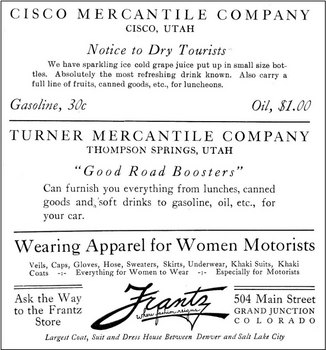
: "God’s Country via Automobile, Scenic Transcontinental Route through the Playground of America", 1915, Colorado-Utah Log book Co.
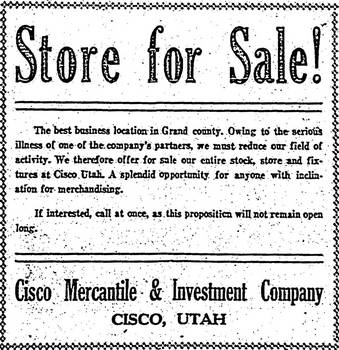 : Sep. 6, 1918 Grand Valley Times
: Sep. 6, 1918 Grand Valley Times
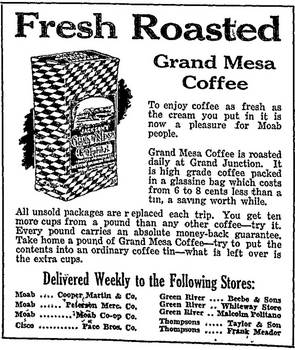 : May 22, 1930 Times Independent
: May 22, 1930 Times Independent
The Pace Brothers Company succeeded the business in 1925[13]. Lynn Sargent Pace(1889 ー 1929) took charge of the Mercantile business.
However, unfortunately, the store burnt to the ground on New Year's Eve the same year[14]. Pace Brothers rebuilt and reopened the store in 1926[15]. This structure, built by White, Okey, and Jones of Montrose survived well into the 70s.
In 1935, Covey Murray(1887 ー 1970) and his brother, State Highway Department foreman, Victor Kirby Murray(1893 ー 1962) bought the property from The Pace Brothers Company with Albert Verne Cain(1905 ー 1982) and started the store and filling station[16].
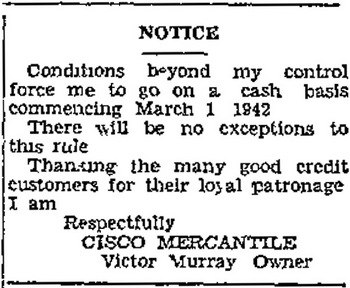 : Feb. 19, 1942 Times Independent
: Feb. 19, 1942 Times Independent
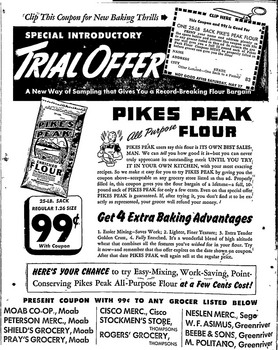 : May 18, 1944 Times Independent
: May 18, 1944 Times Independent
William Richard "Bill"(1889 ー 1971) and Mattie Gertrude Holder(1888 ー 1961) Cowger succeeded the business in 1944[17]. Bill and Mattie later became the “Mom and Pop” of Cisco. The neon signs were put up in 1949[18].
According to the caption added to the 1959 photo by Magnum Photos cameraman Erich Hartmann, “Mom and Pop” ran the motel, bar, restaurant, and a local museum[19]. The bar and matching whiskey cabinet that appears in Hartmann's photo were made by a cabinetmaker, J. C. Poulson, of Denver, CO. in 1848[20].
In 1965, the Mercantile boasted of a bar cafe, a mercantile, a ten-unit motel, and three dwelling houses[21].
In the late 60s, William Woodrow(1918 ー 1984) and Martha M. Walker were the operators of the Mercantile[22]. William's sister-in-law, Helen Lavita Bylerly Walker(1906 ー 1979) acted as the postmistress in 1971; the post office function moved into the Mercantile in 1967[23].
Unfortunately, however, the Annual Financial Statement For the Year Ending Dec. 31, 1971 shows the latest evidence of the survival of the business to this day[24].
According to 1972 Delinquent Tax List, second twin Rillie Nitchie Cowger Beller(1889 ー 1980), Jacob "Jake" Oliver(1907 ー 1991), and Evelyn Boyles succeeded the properties after the demise of Bill Cowger[25]. They put the properties up for final tax sale in 1973[26].
Laurence Walker "Shorty" Hale(1901 ー 1980) of Ethel's Cafe was holding rooster fights in the basement of the closed store, according to Thompson resident AJ Rogers.
1978 Delinquent Tax List has names of Salt Lake City contractor Alexander Louis Jr(1931 ー 1990) and Betty Louise Mast(1934 ー 2008) Quigley as the owner of the property[27].
The structure was entirely destroyed by the fire on June 22, 1979[28].
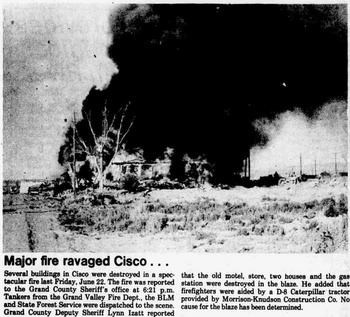 : Jun. 28, 1979 Times Independent
: Jun. 28, 1979 Times Independent
The Mercantile structure built in 1926 featured;
ー"the most modern establishment".
ー"It has a full basement with a heating plant refrigeration system and private electric lighting system".
ー"A massive vault of fireproof construction had also been provided. The building had hardwood floors throughout and the shelving and storage bins follow a style used in the most modern stores throughout the country".
ー"A plate glass front and cement sidewalk added to the attractiveness of the store. The interior of the building was finished in white"[15].
The structure was made of pink-colored concrete blocks called “Pink Brick” with a pin-ribbed surface[29]. Concrete blocks came to produce in the early 1900s in Colorado and Utah[30, 31].
The size of the block seemed nonstandard: the estimated size of the block used here was the 12” x 8” x 5” “Stretcher” type. The 2017 survey confirmed the estimate as shown in the photos below.
I referred to the 1969 aerial photo provided by the U.S. Geological Survey (USGS) to draw the plans. I also counted the block joints in the photos to infer the dimensions. The result is shown below. Of course, some imaginations−especially the interior walls−are included.
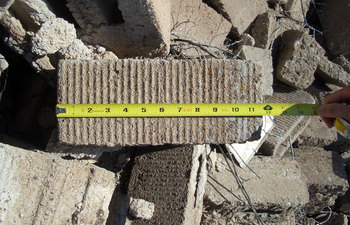 : 12” width, Sep. 10, 2017
: 12” width, Sep. 10, 2017
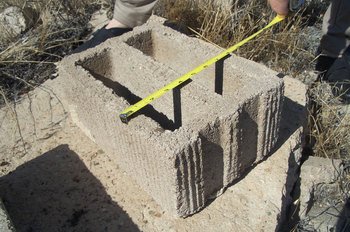 : 8” depth, Sep. 10, 2017
: 8” depth, Sep. 10, 2017
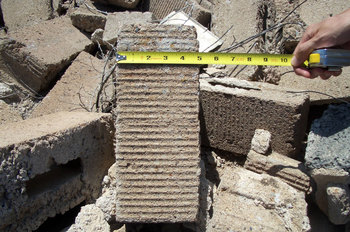 : 5” height, Sep. 10, 2017
: 5” height, Sep. 10, 2017
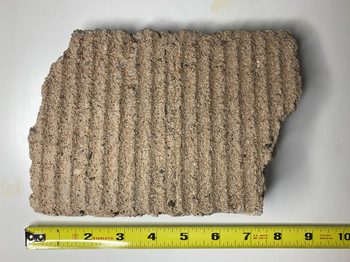 : texture
: texture
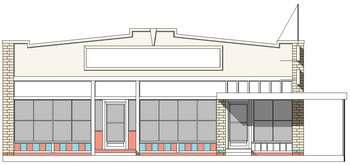 : north elevation
: north elevation
 : west elevation
: west elevation
[1] John Barriger III photo;
[2] Hepperle, Mary L. "Memories of Cisco", Canyon Legacy, vol. 51, Moab Museum, 2004;
[3] Cook, Kenneth L. "Gravity Base Station Network in Utah-1967", Bulletin 92, Utah Geological and Mineralogical Survey, 1971;
[4] Jordan, Kathy. "‘Uranium King’ Charlie Steen started out in Cisco tarpaper shack", Mar. 24, 2011 Daily Sentinel;
[5] Weis, Norman D. Helldorados, Ghosts and Camps of the Old Southwest, Caxton Printers, Ltd. 1977
[6] David photo, flickr;
[7] Dec. 23, 1898, Grand Valley Times;
[8] Aug. 12, 1904 Grand Valley Times;
[9] Jan. 20, 1905 Grand Valley times;
[10] Feb. 21, 1913 Grand Valley Times;
[11] Sep. 6, 1918 Grand Valley Times;
[12] Apr. 18, 1919 Grand Valley Times;
[13] May 21, 1925 Times Independent;
[14] Jan. 7, 1926 Times Independent;
[15] Jun. 24, 1926 Times Independent;
[16] Mar. 7, 1935 Times Independent;
[17] May 11, 1944 Times Independent;
[18] May 10, 1949 Daily Sentinel;
[19] Erich Hartmann photo, Magnum Photos;
[20] Pogue, Mary., Stocks, Verona. "Cisco", Grand Memories, Daughters of Utah Pioneers, 1972
[21] Oct. 1, 1965 Daily Sentinel;
[22] Jul. 27, 1969 Daily Sentinel;
[23] Apr. 29, 1971 Daily Sentinel;
[24] Feb. 25, 1971 Times Independent;
[25] Dec. 28, 1972 Times Independent;
[26] Apr. 26, 1973 Times-Independent;
[27] Dec. 28, 1978 Times Independent;
[28] Jun. 28, 1979 Times Independent;
[29] Jul. 21, 1955 Green River Journal;
[30] Oct. 30, 1905 Salt Lake Mining Review;
[31] May 21, 1904 Daily Sentinel;
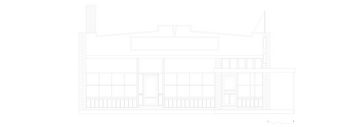 : south elevation, revised
: south elevation, revised
 : west elevation, revised
: west elevation, revised
 : east elevation, revised
: east elevation, revised
 : south elevation, revised
: south elevation, revised
 : first floor plan, revised
: first floor plan, revised
I’m trying to duplicate the whole town of Cisco, Utah in N scale. This post introduces one of the structures in the town.
A few businesses survived along US Hwy 50 & 6 at Cisco in the early 70s; 4 gas service stations, a mercantile/cafe, and a motel. Some private houses also seem to exist along Second Street. Next to Ruth 66 Cafe on the west sat this structure on Lot 1 to 7 of Block 5, Cisco Townsite.
In the photo by John Barriger III taken no later than 1940, the west and north elevation of the structure are barely seen[1].
In the 1946 photo appeared in Canyon Legacy, a part of the south elevation of the structure is seen[2].
In the 1967 photo appeared in Gravity Base Station Network in Utah, the structure is barely seen[3].
In the 1969 photo appeared in Daily Sentinel, the north and east elevation of the structure are barely seen[4].
In the 1971 movie Vanishing Point, the upraised “Cisco MOTEL”, and “CAFE” neon signs, and the “SANDWICHES and COLD DRINKS” advertisement on the wall are seen.
In the book Helldorados, Ghosts and Camps of the Old Southwest, both the closed storefront and the east elevation of the structure are seen[5].
In the 1978 photo at the Flickr site, the closed storefront of the structure is clearly seen[6].
George Washington Sadler(1864 ー 1921) established a grocery at Cisco in 1898[7]. Moab merchant Hammond & Sons Company also had a branch store managed by Wallace Owen Knight(1879 ー 1958) which burnt to the ground on Aug. 8, 1904[8].
Victor Putman Hanson(1841 ー 1920) established the Cisco Mercantile Company in 1905[9]. Benjamin Harrison(1888 ー 1978) and Owen Leslie(1890 ー 1965) Simpson co-owned the business at least from 1913 to 1918 when they sold it to James Guyn(1879 - 1968) and Douglas Morton(1886 ー 1977) McBride[10, 11, 12]. James was the manager of the Simpsons' business.

: "God’s Country via Automobile, Scenic Transcontinental Route through the Playground of America", 1915, Colorado-Utah Log book Co.
 : Sep. 6, 1918 Grand Valley Times
: Sep. 6, 1918 Grand Valley Times : May 22, 1930 Times Independent
: May 22, 1930 Times IndependentThe Pace Brothers Company succeeded the business in 1925[13]. Lynn Sargent Pace(1889 ー 1929) took charge of the Mercantile business.
However, unfortunately, the store burnt to the ground on New Year's Eve the same year[14]. Pace Brothers rebuilt and reopened the store in 1926[15]. This structure, built by White, Okey, and Jones of Montrose survived well into the 70s.
In 1935, Covey Murray(1887 ー 1970) and his brother, State Highway Department foreman, Victor Kirby Murray(1893 ー 1962) bought the property from The Pace Brothers Company with Albert Verne Cain(1905 ー 1982) and started the store and filling station[16].
 : Feb. 19, 1942 Times Independent
: Feb. 19, 1942 Times Independent : May 18, 1944 Times Independent
: May 18, 1944 Times IndependentWilliam Richard "Bill"(1889 ー 1971) and Mattie Gertrude Holder(1888 ー 1961) Cowger succeeded the business in 1944[17]. Bill and Mattie later became the “Mom and Pop” of Cisco. The neon signs were put up in 1949[18].
According to the caption added to the 1959 photo by Magnum Photos cameraman Erich Hartmann, “Mom and Pop” ran the motel, bar, restaurant, and a local museum[19]. The bar and matching whiskey cabinet that appears in Hartmann's photo were made by a cabinetmaker, J. C. Poulson, of Denver, CO. in 1848[20].
In 1965, the Mercantile boasted of a bar cafe, a mercantile, a ten-unit motel, and three dwelling houses[21].
In the late 60s, William Woodrow(1918 ー 1984) and Martha M. Walker were the operators of the Mercantile[22]. William's sister-in-law, Helen Lavita Bylerly Walker(1906 ー 1979) acted as the postmistress in 1971; the post office function moved into the Mercantile in 1967[23].
Unfortunately, however, the Annual Financial Statement For the Year Ending Dec. 31, 1971 shows the latest evidence of the survival of the business to this day[24].
According to 1972 Delinquent Tax List, second twin Rillie Nitchie Cowger Beller(1889 ー 1980), Jacob "Jake" Oliver(1907 ー 1991), and Evelyn Boyles succeeded the properties after the demise of Bill Cowger[25]. They put the properties up for final tax sale in 1973[26].
Laurence Walker "Shorty" Hale(1901 ー 1980) of Ethel's Cafe was holding rooster fights in the basement of the closed store, according to Thompson resident AJ Rogers.
1978 Delinquent Tax List has names of Salt Lake City contractor Alexander Louis Jr(1931 ー 1990) and Betty Louise Mast(1934 ー 2008) Quigley as the owner of the property[27].
The structure was entirely destroyed by the fire on June 22, 1979[28].
 : Jun. 28, 1979 Times Independent
: Jun. 28, 1979 Times IndependentThe Mercantile structure built in 1926 featured;
ー"the most modern establishment".
ー"It has a full basement with a heating plant refrigeration system and private electric lighting system".
ー"A massive vault of fireproof construction had also been provided. The building had hardwood floors throughout and the shelving and storage bins follow a style used in the most modern stores throughout the country".
ー"A plate glass front and cement sidewalk added to the attractiveness of the store. The interior of the building was finished in white"[15].
The structure was made of pink-colored concrete blocks called “Pink Brick” with a pin-ribbed surface[29]. Concrete blocks came to produce in the early 1900s in Colorado and Utah[30, 31].
The size of the block seemed nonstandard: the estimated size of the block used here was the 12” x 8” x 5” “Stretcher” type. The 2017 survey confirmed the estimate as shown in the photos below.
I referred to the 1969 aerial photo provided by the U.S. Geological Survey (USGS) to draw the plans. I also counted the block joints in the photos to infer the dimensions. The result is shown below. Of course, some imaginations−especially the interior walls−are included.
 : 12” width, Sep. 10, 2017
: 12” width, Sep. 10, 2017 : 8” depth, Sep. 10, 2017
: 8” depth, Sep. 10, 2017 : 5” height, Sep. 10, 2017
: 5” height, Sep. 10, 2017 : texture
: texture : north elevation
: north elevation : west elevation
: west elevationrevised Dec. 24, 2013
revised Sep. 22, 2014
revised Jan. 7, 2015
revised Feb. 4, 2015
revised Mar. 2, 2015
revised Oct. 10, 2015
revised Dec. 11, 2015
revised Oct. 23, 2016
revised Dec. 26, 2016
revised Feb. 19, 2018
revised Mar. 8, 2018
revised Nov. 10, 2018
revised Jan. 5, 2020
revised Mar. 2, 2021
revised Jul. 24, 2021
revised Aug. 5, 2021
revised, Sep. 23, 2022
revised, Apr. 14, 2023
[1] John Barriger III photo;
[2] Hepperle, Mary L. "Memories of Cisco", Canyon Legacy, vol. 51, Moab Museum, 2004;
[3] Cook, Kenneth L. "Gravity Base Station Network in Utah-1967", Bulletin 92, Utah Geological and Mineralogical Survey, 1971;
[4] Jordan, Kathy. "‘Uranium King’ Charlie Steen started out in Cisco tarpaper shack", Mar. 24, 2011 Daily Sentinel;
[5] Weis, Norman D. Helldorados, Ghosts and Camps of the Old Southwest, Caxton Printers, Ltd. 1977
[6] David photo, flickr;
[7] Dec. 23, 1898, Grand Valley Times;
[8] Aug. 12, 1904 Grand Valley Times;
[9] Jan. 20, 1905 Grand Valley times;
[10] Feb. 21, 1913 Grand Valley Times;
[11] Sep. 6, 1918 Grand Valley Times;
[12] Apr. 18, 1919 Grand Valley Times;
[13] May 21, 1925 Times Independent;
[14] Jan. 7, 1926 Times Independent;
[15] Jun. 24, 1926 Times Independent;
[16] Mar. 7, 1935 Times Independent;
[17] May 11, 1944 Times Independent;
[18] May 10, 1949 Daily Sentinel;
[19] Erich Hartmann photo, Magnum Photos;
[20] Pogue, Mary., Stocks, Verona. "Cisco", Grand Memories, Daughters of Utah Pioneers, 1972
[21] Oct. 1, 1965 Daily Sentinel;
[22] Jul. 27, 1969 Daily Sentinel;
[23] Apr. 29, 1971 Daily Sentinel;
[24] Feb. 25, 1971 Times Independent;
[25] Dec. 28, 1972 Times Independent;
[26] Apr. 26, 1973 Times-Independent;
[27] Dec. 28, 1978 Times Independent;
[28] Jun. 28, 1979 Times Independent;
[29] Jul. 21, 1955 Green River Journal;
[30] Oct. 30, 1905 Salt Lake Mining Review;
[31] May 21, 1904 Daily Sentinel;
 : south elevation, revised
: south elevation, revised : west elevation, revised
: west elevation, revised : east elevation, revised
: east elevation, revised : south elevation, revised
: south elevation, revised : first floor plan, revised
: first floor plan, revised2013-11-08 09:00
コメント(1)
Cisco Motel [Column_Cisco Townsite]
: site of Cisco Motel
I’m trying to duplicate the whole town of Cisco, Utah in N scale. This post introduces one of the structures in the town.
A few businesses survived along US Hwy 50 & 6 at Cisco in the early 70s; 4 gas service stations, a mercantile/cafe, and a motel. Some private houses also seem to exist along Second Street. Next to Cisco Mercantile on the west sat this structure on Lot 1 to 7 of Block 5, Cisco Townsite.
In the 1971 movie Vanishing Point, the north and west elevations of the structure are seen. West elevation photo of the structure is also found in the book Helldorados, Ghosts and Camps of the Old Southwest[1].
There once existed the Cisco Hotel/Hotel Cisco/Hotel de Cisco next to the Ruth 66 Cafe structure on the west side at Block 6, Cisco Townsite[2, 3].
The Cisco Hotel was erected no later than 1905 by Victor Putman Hanson(1841 ー 1920)[4, 5]. It hosted ten guests at $1.50 a day[5]. William Andrew Shideler(1872 ー 1939) was the proprietor of the hotel between 1911 and 1919[6]. He rebuilt the hotel structure in 1917[7]. Henry Hansen(1860 ー 1932) was the proprietor in 1919, Dean L. Edwards(1874 ー ?) was the proprietor the next year, and William Talmadge Portis(1871 ー 1942) was the proprietor in 1922. Patrick Franklin Dyer(1861 ー 1936) succeeded the business the same year and operated until his passage in 1936[8, 9].
The structure built in 1917 moved to nearby Moab in 1940 and became Moab Hotel operated by Jack and Katherine Poole(1899 ー 1976) Rauer[10, 11, 12]. It is said that the structure was cut into blocks and carried by a float on the Colorado River. Furthermore, the structure moved several blocks in 2008 again. It still remains today as a private residence.
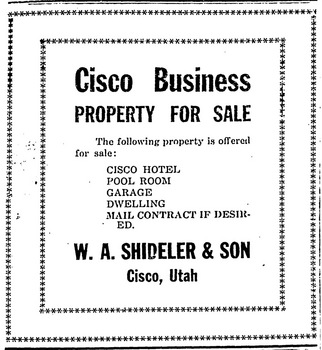 : Dec. 4, 1919 Times Independent
: Dec. 4, 1919 Times Independent
The ten-unit motel was constructed after the removal of the hotel[13]. It was verified between 1944 and 1953 as Cowger’s Motel operated by William Richard "Bill"(1889 ー 1971) and Mattie Gertrude Holder(1888 ー 1961) Cowger[14]. It was claimed as Cisco Motel in the 1970 Notice of General Election; it was used as the polling place between 1964 and 1970[15, 16].
The customers of the motel were gas well crews such as Texaco Oil rather than tourists in the late 40s[17]. Weis, who visited the town in the mid-70s, no later than 1975, reports that the Motel advertised "every room individually heated"[1]. The heating device was a stove burning natural gas[18].
In the late 60s, William Woodrow(1918 ー 1984) and Martha M. Walker succeeded the Mercantile business, but not the Motel[19]. William Cowger passed away in 1971 and the successors put the properties up for final tax sale in 1973[20].
"The motel in Cisco it presently occupied by chickens," wrote Val Sullivan in 1979[21]. The chickens must have participated in the rooster fights held in the basement of the closed Mercantile building those days.
1978 Delinquent Tax List has names of Salt Lake City contractor Alexander Louis, Jr(1931 ー 1990) and Betty Louise(1934 ー 2008) Quigley as the owner of the property[22]. However, unfortunately, it was burnt to the ground in 1979[23]. Today, nothing is left but the curbstones as you can see above.
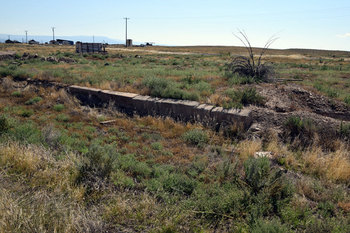 : Cisco, UT Sep. 11, 2014
: Cisco, UT Sep. 11, 2014
I used the screenshot of the movie to draw plans. I also used the 1969 and 1974 USGS aerial photos to infer the dimensions. The result is shown below. Of course, some imaginations are included; particularly in the east elevation.
[1] Weis, Norman D., (1977) Helldorados, Ghosts and camps of the old Southwest, Caxton Printers
[2] Sep. 11, 1969 Times Independent;
[3] John Barriger III photo of the Hotel and the Mercantile;;
[4] Jan. 21, 1905 Grand Valley Times;
[5] Hooper, S. K., (1906) Hotels and Boarding Houses located on the line of The Rio Grande Railroad System, Circular No.74, Passenger Department, Denver and Rio Grande R.R.
[6] May 16, 1913 Grand Valley Times;
[7] May 11, 1917 Grand Valley Times;
[8] Nov. 23, 1922 Times Independent;
[9] Oct. 22, 1936 Times Independent;
[10] Apr. 18, 1940 Times Independent;
[11] Nov. 10, 1994 Times Independent;
[12] Apr. 24, 1940 Daily Sentinel;
[13] Oct. 1, 1965 Daily Sentinel;
[14] Bennett, Lee A., (2009) A History of Selected Ranches on the Colorado River, Bennett Management Services, LLC;
[15] Oct. 29, 1970 Times Independent;
[16] Apr. 8, 1965 Times Independent;
[17] Hepperle, Mary L., (2004) "Memories of Cisco", Canyon Legacy, vol. 51, Moab Museum;
[18] Sep. 22, 1964 Daily Sentinel;
[19] Jul. 27, 1969 Daily Sentinel;
[20] Apr. 26, 1973 Times Independent;
[21] Jul. 1, 1979 Daily Sentinel;
[22] Dec. 28, 1978 Times Independent;
[23] Jun. 28, 1979 Times Independent;
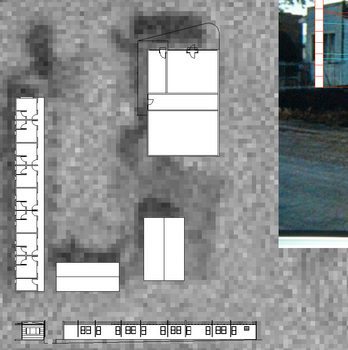 : references and the drawings of Cisco Motel
: references and the drawings of Cisco Motel
 : Cisco Motel, east, north and west elevation
: Cisco Motel, east, north and west elevation
I’m trying to duplicate the whole town of Cisco, Utah in N scale. This post introduces one of the structures in the town.
A few businesses survived along US Hwy 50 & 6 at Cisco in the early 70s; 4 gas service stations, a mercantile/cafe, and a motel. Some private houses also seem to exist along Second Street. Next to Cisco Mercantile on the west sat this structure on Lot 1 to 7 of Block 5, Cisco Townsite.
In the 1971 movie Vanishing Point, the north and west elevations of the structure are seen. West elevation photo of the structure is also found in the book Helldorados, Ghosts and Camps of the Old Southwest[1].
There once existed the Cisco Hotel/Hotel Cisco/Hotel de Cisco next to the Ruth 66 Cafe structure on the west side at Block 6, Cisco Townsite[2, 3].
The Cisco Hotel was erected no later than 1905 by Victor Putman Hanson(1841 ー 1920)[4, 5]. It hosted ten guests at $1.50 a day[5]. William Andrew Shideler(1872 ー 1939) was the proprietor of the hotel between 1911 and 1919[6]. He rebuilt the hotel structure in 1917[7]. Henry Hansen(1860 ー 1932) was the proprietor in 1919, Dean L. Edwards(1874 ー ?) was the proprietor the next year, and William Talmadge Portis(1871 ー 1942) was the proprietor in 1922. Patrick Franklin Dyer(1861 ー 1936) succeeded the business the same year and operated until his passage in 1936[8, 9].
The structure built in 1917 moved to nearby Moab in 1940 and became Moab Hotel operated by Jack and Katherine Poole(1899 ー 1976) Rauer[10, 11, 12]. It is said that the structure was cut into blocks and carried by a float on the Colorado River. Furthermore, the structure moved several blocks in 2008 again. It still remains today as a private residence.
 : Dec. 4, 1919 Times Independent
: Dec. 4, 1919 Times IndependentThe ten-unit motel was constructed after the removal of the hotel[13]. It was verified between 1944 and 1953 as Cowger’s Motel operated by William Richard "Bill"(1889 ー 1971) and Mattie Gertrude Holder(1888 ー 1961) Cowger[14]. It was claimed as Cisco Motel in the 1970 Notice of General Election; it was used as the polling place between 1964 and 1970[15, 16].
The customers of the motel were gas well crews such as Texaco Oil rather than tourists in the late 40s[17]. Weis, who visited the town in the mid-70s, no later than 1975, reports that the Motel advertised "every room individually heated"[1]. The heating device was a stove burning natural gas[18].
In the late 60s, William Woodrow(1918 ー 1984) and Martha M. Walker succeeded the Mercantile business, but not the Motel[19]. William Cowger passed away in 1971 and the successors put the properties up for final tax sale in 1973[20].
"The motel in Cisco it presently occupied by chickens," wrote Val Sullivan in 1979[21]. The chickens must have participated in the rooster fights held in the basement of the closed Mercantile building those days.
1978 Delinquent Tax List has names of Salt Lake City contractor Alexander Louis, Jr(1931 ー 1990) and Betty Louise(1934 ー 2008) Quigley as the owner of the property[22]. However, unfortunately, it was burnt to the ground in 1979[23]. Today, nothing is left but the curbstones as you can see above.
 : Cisco, UT Sep. 11, 2014
: Cisco, UT Sep. 11, 2014I used the screenshot of the movie to draw plans. I also used the 1969 and 1974 USGS aerial photos to infer the dimensions. The result is shown below. Of course, some imaginations are included; particularly in the east elevation.
revised Sep. 30, 2014
revised, Jan. 7, 2015
revised, Aug. 7, 2015
revised, Oct. 23, 2016
revised, Dec. 28, 2016
revised, Jan. 31, 2017
revised Feb. 17, 2018
revised Jan. 6, 2020
revised Nov. 5, 2021
revised Sep. 23, 2022
revised Apr. 18, 2023
[1] Weis, Norman D., (1977) Helldorados, Ghosts and camps of the old Southwest, Caxton Printers
[2] Sep. 11, 1969 Times Independent;
[3] John Barriger III photo of the Hotel and the Mercantile;;
[4] Jan. 21, 1905 Grand Valley Times;
[5] Hooper, S. K., (1906) Hotels and Boarding Houses located on the line of The Rio Grande Railroad System, Circular No.74, Passenger Department, Denver and Rio Grande R.R.
[6] May 16, 1913 Grand Valley Times;
[7] May 11, 1917 Grand Valley Times;
[8] Nov. 23, 1922 Times Independent;
[9] Oct. 22, 1936 Times Independent;
[10] Apr. 18, 1940 Times Independent;
[11] Nov. 10, 1994 Times Independent;
[12] Apr. 24, 1940 Daily Sentinel;
[13] Oct. 1, 1965 Daily Sentinel;
[14] Bennett, Lee A., (2009) A History of Selected Ranches on the Colorado River, Bennett Management Services, LLC;
[15] Oct. 29, 1970 Times Independent;
[16] Apr. 8, 1965 Times Independent;
[17] Hepperle, Mary L., (2004) "Memories of Cisco", Canyon Legacy, vol. 51, Moab Museum;
[18] Sep. 22, 1964 Daily Sentinel;
[19] Jul. 27, 1969 Daily Sentinel;
[20] Apr. 26, 1973 Times Independent;
[21] Jul. 1, 1979 Daily Sentinel;
[22] Dec. 28, 1978 Times Independent;
[23] Jun. 28, 1979 Times Independent;
 : references and the drawings of Cisco Motel
: references and the drawings of Cisco Motel : Cisco Motel, east, north and west elevation
: Cisco Motel, east, north and west elevation2014-02-21 09:00
コメント(0)
Duke's Service Adjoint [Column_Cisco Townsite]
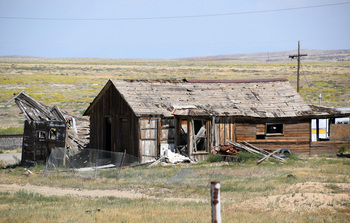 : Cisco, UT. Sep. 11, 2014
: Cisco, UT. Sep. 11, 2014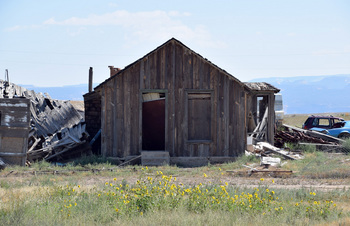 : Cisco, UT. Sep. 11, 2014
: Cisco, UT. Sep. 11, 2014I’m trying to duplicate the whole town of Cisco, Utah in N scale. This post introduces one of the structures in the town.
A few businesses survived along US Hwy 50 & 6 at Cisco in the early 70s; 4 gas service stations, a mercantile/cafe, and a motel. Some private houses also seem to exist along Second Street. Next to Duke's Service on the south sat this structure on Block 2, Cisco Townsite.
This structure appears in the 1990 movie Thelma and Louise as the house of an old man acted by a Cisco resident Ernest Earl Vanderhoff(1935 − 1995). It has a red line painted on the wall at the same height as the Duke's Service structure in the 1971 movie Vanishing Point
A little three-room house William Wilbur(1896 − 1972) and Marjorie M. Dufford(1900 − 1981) Howland bought at Green River in 1920 was later moved to Cisco, and became Texaco Service Station[1]. Duke's Service used to be the only station to sell Texaco gas within Cisco townsite. Thus, Duke's Service Adjoint must have been the very structure moved from Green River some time.
Eppie Nettice Fanning Capansky(1890 − 1976), the proprietor of the Duke's Service, claims the structure as an "adjoining dwelling" in the newspaper advertisement[2]. Accordingly, the structure must have been used as a living quarter for the proprietor or the operator of Duke's Service.
 : July 21, 1955 Green River Journal
: July 21, 1955 Green River JournalThe structure barely survived as of 2014 when I visited. I took pictures and peeped inside which proved to be empty without any partitions.
An aerial photo of Google Maps helped me to infer the dimensions. Former Rio Grande tracks on the opposite side of the road brought me the approximate scale. The result is shown below. Of course, some imaginations are included.
revised, Sep. 29, 2014
revised, Dec. 15, 2014
revised, Jan. 7, 2015
revised, Dec. 29, 2016
revised, Sep. 23, 2022
revised, Mar. 13, 2023
[1] Apr. 2, 1970 Times Independent;
[2] Mar. 30, 1960 Times Independent;
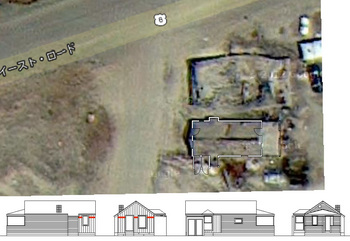 : references and the drawings of Duke's Service Adjoint
: references and the drawings of Duke's Service Adjoint : East, North and West elevation
: East, North and West elevation2014-05-02 09:00
コメント(0)
Capansky's Garage and Dwelling [Column_Cisco Townsite]
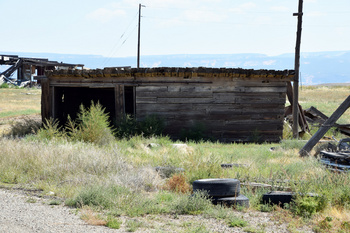 : the garage
: the garage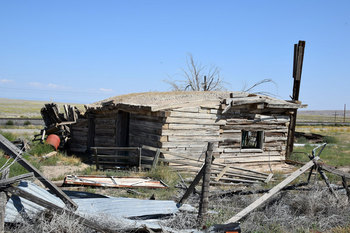 : the dwelling
: the dwellingI’m trying to duplicate the whole town of Cisco, Utah in N scale. This post introduces one of the structures in the town.
A few businesses survived along US Hwy 50 & 6 at Cisco in the early 70s; 4 gas service stations, a mercantile/cafe, and a motel. Some private houses also seem to exist along Second Street. These structures sat beside Duke's Service on the east of Block 2, Cisco Townsite.
People at Cisco went out in the desert and gathered the left ties to build their houses[1]. Denver & Rio Grande Western Railroad converted and relocated its narrow gauge mainline through Cisco in 1890. Decades later, in 1962, the portion of the curvy mainline including the Cottonwood siding east of Cisco was relocated, and, by 1969, the tight curve on its mainline located just west of the town was loosened[2, 3]. The standard ties used for the narrow gauge track were six feet long, and those used for the standard gauge track were nine feet long.
Block 2, Cisco Townsite was long owned by William Boston(1887 - 1951) and Eppie Nettice Fanning(1892 - 1976) Capansky, at least since 1931[4]. They came to Cisco in 1925[5].
William opened up the garage made of old railroad ties no later than in 1927[6]. The ties used seem the standard gauge ties according to their length. They lived in the adjoining house also made of old ties before they purchased and relocated a house from Green River. They established the gas service station next to the Garage in 1934.
The structures still survived, but in a rather obsolete style, when I visited in 2014. I used Google Maps to infer the dimensions of the structure to draw plans. I also referred to the photos found on the web. The result is shown below: of course, some imaginations are included.
All the photos were taken on Sep. 11, 2014.
revised, Jan. 31, 2017
revised, Jan. 29, 2018
revised, Mar. 13, 2023
revised, Oct. 17, 2023
revised, Apr. 14, 2024
[1] Dalton, Vonna Foy. “Some Remembrances of Picture Gallery and Cisco”, #51, Canyon Regacy, Moab Museum, 2004
[2] Jan. 11, 1962 Times Independent;
[3] 1969 USGS aerial photo
[4] Dec. 17, 1931 Times Independent;
[5] Jul. 27, 1969 Daily Sentinel;
[6] Jul. 21, 1927 Times-Independent;
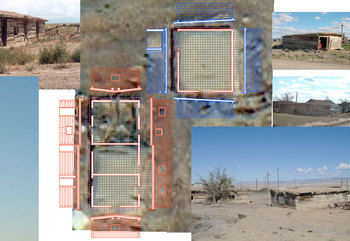 : references and the drawings of garage and dwelling
: references and the drawings of garage and dwelling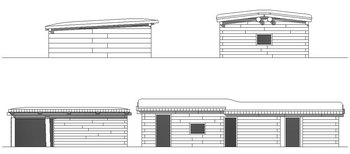 : north and west elevations of garage and dwelling
: north and west elevations of garage and dwelling2014-11-21 09:00
コメント(0)
Maynard House [Column_Cisco Townsite]
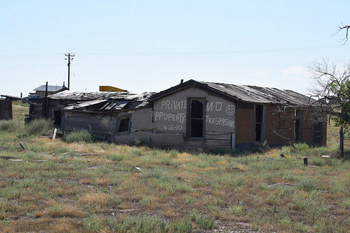 : looking from northwest
: looking from northwest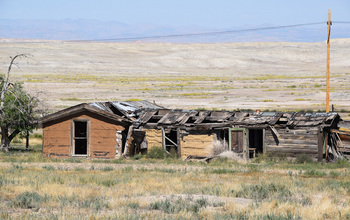 : looking from southeast
: looking from southeastI’m trying to duplicate the whole town of Cisco, Utah in N scale. This post introduces one of the structures in the town.
A few businesses survived along US Hwy 50 & 6 at Cisco in the early 70s; 4 gas service stations, a mercantile/cafe, and a motel. Some private houses also seem to exist along Second Street. Between Duke's Service and Ruth 66 Cafe sat this structure at Lot 22, Block 7, Cisco Townsite.
This structure is probably the oldest existing structure in Cisco. The structure is barely seen in the 1944 USGS aerial photo. The same structure is verified as the "Meeker log cabin" in a map representing Cisco in the late 40s[1].
The structure was originally built by Victor Putman Hanson(1841 – 1920) who established the Cisco Townsite, Cisco Hotel, and other principal facilities of the town[2]. According to Vonna Lucinda Foy Dalton(1921 – 2016), part of it had been an original schoolhouse retired in 1919[3].
It was used as the winter headquarters of Fitzpatrick Brothers, a ranch operated by James Henry(1880 – 1928) and William Thomas(1887 – 1933) Fitzpatrick of Montrose, CO. at least in 1923[2]. They were raising sheep in the region.
Ralph Dalton(1916 – 2002) and his family rented and lived in this structure between 1938 and 1944[3, 4].
Frank Meaker(1884 – 1972) of Montrose, CO. owned the lot at least from 1944[5]. He was raising sheep in the region. Elton Richard Cowger(1915 – 1984) and his family who came to Cisco that year rented and lived in this structure until 1950[6].
John Aubrey Maynard(1895 – 1972) succeeded the property in 1959[7]. Aubrey was a sheepman and also a D&RGW hand treating water here[1, 8].
John's niece Sandra and Jay A. Williams keep the house to this day[9].
The structure exists in a rather obsolete style, as you can see above. I used Google Maps to infer the dimensions of the structure to draw plans. The result is shown below; of course, some imaginations are included.
All photos were taken on Sep. 11, 2014
revised, Feb. 4, 2016
revised, Jan. 26, 2017
revised, Jan. 29, 2018
revised, Apr. 14, 2023
[1] Hepperle, Mary L. Cowger. "Memories of Cisco", Canyon Legacy, Vol. 51, Moab Museum, 2004
[2] May 3, 1923 Times Independent
[3] Dalton, Vonna Foy. “Some Remembrances of Picture Gallery and Cisco”, #51, Canyon Regacy, Moab Museum, 2004;
[4] Mar. 2, 1944 Times Independent;
[5] Dec. 7, 1944 Times Independent;
[6] Hepperle, Mary L., (2004) "Memories of Cisco", Canyon Legacy, vol. 51, Moab Museum;
[7] Dec. 17, 1959 Times Independent;
[8] Oct. 31, 1940 Times Independent;
[9] Williams, Sandra (2013) "Notes", J Aubrey Maynard, Find a Grave;
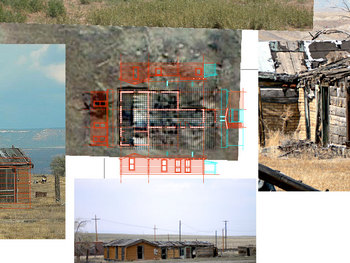 : references and the drawings of Maynard House
: references and the drawings of Maynard House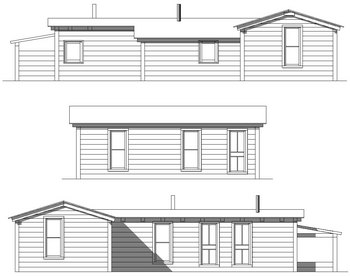 : north, west and south elevation of Maynard House
: north, west and south elevation of Maynard House2015-03-20 09:00
コメント(0)
McCoy’s Service [Column_Cisco Townsite]
: site of McCoy's Service
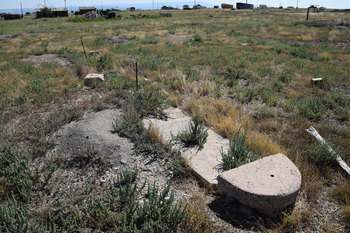 : Cisco, UT. Sep. 11, 2014
: Cisco, UT. Sep. 11, 2014
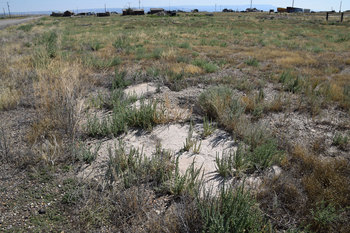 : Cisco, UT. Sep. 11, 2014
: Cisco, UT. Sep. 11, 2014
I’m trying to duplicate the whole town of Cisco, Utah in N scale. This post introduces one of the structures in the town.
A few businesses survived along US Hwy 50 & 6 at Cisco in the early 70s; 4 gas service stations, a mercantile/cafe, and a motel. Some private houses also seem to exist along Second Street. Between Cisco Mercantile and Ruth 66 Cafe sat this structure at Block 6, Cisco Townsite.
This little rectangular structure is seen in the 1969 USGS aerial photo. This structure also appears in the 1971 movie Vanishing Point along with three red shining gas pumps. In the movie, a string of colorful but rather faded flags stretches from the Ruth 66 Cafe to this structure. But the windows seem freshly boarded up; it looks like went out of business recently.
The construction of the Midland Trail within Grand County was completed in 1913[1]. The Trail became US Hwy 50 in 1926.
Gas service stations opened up at Cisco in those days. The earliest evidence of the existence of such facilities is the advertisement by Cisco Mercantile in a guidebook printed in 1915. The new "sidewalk gasoline pump" was installed in front of the Mercantile in 1917[2].
In 1924, carpenter M. R. Walker was erecting an addition to the Cisco Sevice Station owned by Eva Flo Davis(1900 ー 1986), spouse of former D&RGW agent William Che Davis(1896 ー 1982)[3]. This Station walker was working on seems the origin of McCoy's Service, as the origins of other gas service businesses −Cisco Mercantile, Duke's Service, Cisco Automotive Service, and Ethel's Cafe− are already verified.
In 1927, Eva and William Davis sold the Cisco Service Station to Patrick Franklin Dyer(1861 ー 1936) who owned the Cisco Hotel and a pool hall on Block 6[4, 5].
Ralph Edwin(1902 ー 1982) and Winnaferd Evelyn(1902 ー 1974) Cato succeeded the business no later than 1928. The facilities consisted of the station, a dwelling room attached to the back of the station, and a bungalow in those days[6]. The facilities can be seen in the photo taken by John Barriger III[7].
In 1932, Loyd H. "Bill" Heel(Heal, 1902 ー 1952) of Grand Junction, CO succeeded the by then White Eagle filling Station[8]. But he was charged with liquor possession a month later.
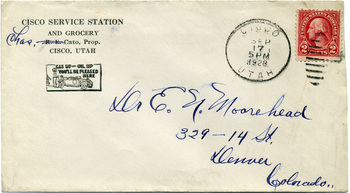 : Cisco Service Station envelope
: Cisco Service Station envelope
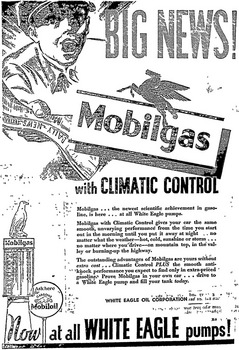 : Oct. 6, 1932 Times Independent
: Oct. 6, 1932 Times Independent
 : Mar. 29, 1962 Times Independent
: Mar. 29, 1962 Times Independent
J. Lowell(1912 ー 1968) and Ruth Maxine Peterson(1918 ー 1999) Mealey came to Cisco in 1956[9]. They started running the J&M CAFE & SERVICE, selling diesel, gas, oil, beer, and food. According to their 1960 advertisement, the business was worth eighty-thousand dollars a year[10].
Teddy D. "Ted"(1935 – 1961) and Jeannie Haeck Johnson succeeded the business in 1961[11]. Unfortunately, however, Ted died accidentally by electrocution the same year[12].
Lloyd Frank(1918 – 1997) and Virginia Labrum Nelson of Mack, CO, the owner of the Fruita Pool Hall, purchased the business in 1963[13]. But whether Nelsons succeeded the business is uncertain.
Ernest Eugene(1923 - 1989) and Ruth Lorene Endicott(1922 – 1986) McCoy of McCoy's Service at Moab purchased the business the same year. Unfortunately, however, Ernest put all of Block 6 up for final tax sale in 1969[14].
The little structure burnt down to the ground on June 22, 1979[15].
I referred to the 1971 movie Vanishing Point and the 1969 USGS aerial photo to draw plans. The result is shown below; of course, some imaginations are included.
[1] Jul. 11, 1913 Grand Valley Times;
[2] Oct. 5, 1917 Times Independent;
[3] Dec. 11, 1924 Times Independent;
[4] Apr. 28, 1927 Times Independent;
[5] Jan. 4, 1923 Times Independent;
[6] Feb. 23, 1928 Times Independent;
[7] John Barriger III photo;
[8] Mar. 3, 1932 Times Independent;
[9] Feb. 20, 1999 Deseret News;
[10] Nov. 20, 1960 Salt lake Tribune;
[11] May 18, 1961 Steamboat Pilot;
[12] May 4, 1961 Times Independent;
[13] May 23, 1963 Times Independent;
[14] May 22, 1969 Times Independent;
[15] Jun. 28, 1979 Times Independent;
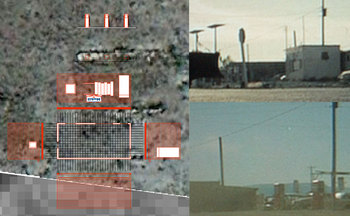 : references and the drawings of McCoy’s Service
: references and the drawings of McCoy’s Service
 : north and west elevations of McCoy’s Service
: north and west elevations of McCoy’s Service
 : Cisco, UT. Sep. 11, 2014
: Cisco, UT. Sep. 11, 2014 : Cisco, UT. Sep. 11, 2014
: Cisco, UT. Sep. 11, 2014I’m trying to duplicate the whole town of Cisco, Utah in N scale. This post introduces one of the structures in the town.
A few businesses survived along US Hwy 50 & 6 at Cisco in the early 70s; 4 gas service stations, a mercantile/cafe, and a motel. Some private houses also seem to exist along Second Street. Between Cisco Mercantile and Ruth 66 Cafe sat this structure at Block 6, Cisco Townsite.
This little rectangular structure is seen in the 1969 USGS aerial photo. This structure also appears in the 1971 movie Vanishing Point along with three red shining gas pumps. In the movie, a string of colorful but rather faded flags stretches from the Ruth 66 Cafe to this structure. But the windows seem freshly boarded up; it looks like went out of business recently.
The construction of the Midland Trail within Grand County was completed in 1913[1]. The Trail became US Hwy 50 in 1926.
Gas service stations opened up at Cisco in those days. The earliest evidence of the existence of such facilities is the advertisement by Cisco Mercantile in a guidebook printed in 1915. The new "sidewalk gasoline pump" was installed in front of the Mercantile in 1917[2].
In 1924, carpenter M. R. Walker was erecting an addition to the Cisco Sevice Station owned by Eva Flo Davis(1900 ー 1986), spouse of former D&RGW agent William Che Davis(1896 ー 1982)[3]. This Station walker was working on seems the origin of McCoy's Service, as the origins of other gas service businesses −Cisco Mercantile, Duke's Service, Cisco Automotive Service, and Ethel's Cafe− are already verified.
In 1927, Eva and William Davis sold the Cisco Service Station to Patrick Franklin Dyer(1861 ー 1936) who owned the Cisco Hotel and a pool hall on Block 6[4, 5].
Ralph Edwin(1902 ー 1982) and Winnaferd Evelyn(1902 ー 1974) Cato succeeded the business no later than 1928. The facilities consisted of the station, a dwelling room attached to the back of the station, and a bungalow in those days[6]. The facilities can be seen in the photo taken by John Barriger III[7].
In 1932, Loyd H. "Bill" Heel(Heal, 1902 ー 1952) of Grand Junction, CO succeeded the by then White Eagle filling Station[8]. But he was charged with liquor possession a month later.
 : Cisco Service Station envelope
: Cisco Service Station envelope : Oct. 6, 1932 Times Independent
: Oct. 6, 1932 Times Independent : Mar. 29, 1962 Times Independent
: Mar. 29, 1962 Times IndependentJ. Lowell(1912 ー 1968) and Ruth Maxine Peterson(1918 ー 1999) Mealey came to Cisco in 1956[9]. They started running the J&M CAFE & SERVICE, selling diesel, gas, oil, beer, and food. According to their 1960 advertisement, the business was worth eighty-thousand dollars a year[10].
Teddy D. "Ted"(1935 – 1961) and Jeannie Haeck Johnson succeeded the business in 1961[11]. Unfortunately, however, Ted died accidentally by electrocution the same year[12].
Lloyd Frank(1918 – 1997) and Virginia Labrum Nelson of Mack, CO, the owner of the Fruita Pool Hall, purchased the business in 1963[13]. But whether Nelsons succeeded the business is uncertain.
Ernest Eugene(1923 - 1989) and Ruth Lorene Endicott(1922 – 1986) McCoy of McCoy's Service at Moab purchased the business the same year. Unfortunately, however, Ernest put all of Block 6 up for final tax sale in 1969[14].
The little structure burnt down to the ground on June 22, 1979[15].
I referred to the 1971 movie Vanishing Point and the 1969 USGS aerial photo to draw plans. The result is shown below; of course, some imaginations are included.
revised Jul. 26, 2016
revised Dec. 29, 2016
revised Jan. 31, 2017
revised Feb. 22, 2018
revised Jan. 6, 2020
revised Apr. 16, 2023
[1] Jul. 11, 1913 Grand Valley Times;
[2] Oct. 5, 1917 Times Independent;
[3] Dec. 11, 1924 Times Independent;
[4] Apr. 28, 1927 Times Independent;
[5] Jan. 4, 1923 Times Independent;
[6] Feb. 23, 1928 Times Independent;
[7] John Barriger III photo;
[8] Mar. 3, 1932 Times Independent;
[9] Feb. 20, 1999 Deseret News;
[10] Nov. 20, 1960 Salt lake Tribune;
[11] May 18, 1961 Steamboat Pilot;
[12] May 4, 1961 Times Independent;
[13] May 23, 1963 Times Independent;
[14] May 22, 1969 Times Independent;
[15] Jun. 28, 1979 Times Independent;
 : references and the drawings of McCoy’s Service
: references and the drawings of McCoy’s Service : north and west elevations of McCoy’s Service
: north and west elevations of McCoy’s Service2015-06-19 09:00
コメント(0)
Ethel’s Cafe [Column_Cisco Townsite]
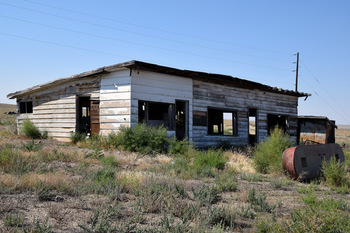 : Cisco, UT. Sep. 11, 2014
: Cisco, UT. Sep. 11, 2014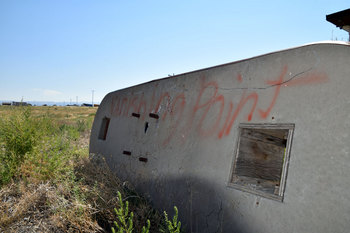 : Cisco, UT. Sep. 11, 2014
: Cisco, UT. Sep. 11, 2014I’m trying to duplicate the whole town of Cisco, Utah in N scale. This post introduces one of the structures in the town.
A few businesses survived along US Hwy 50 & 6 at Cisco in the early 70s; 4 gas service stations, a mercantile/cafe, and a motel. Some private houses also seem to exist along Second Street. Westernmost of the town sat this structure at Block 4, Cisco Townsite.
Block 4 itself was long owned by a sheepman Robert Frederick Burford(1865 – 1929) until 1936[1]. In the 30s, a structure on Block 4 was owned by Virginia Frances Paxton Gruver(1898 – 1978)[2]. She ran a boarding house until 1942 and rented it to Roscoe Clarence Hallett(1890 – 1971) afterward [3, 1]. Later, Mrs. Margaret Hess was the owner of Block 4 in 1964[4].
The glory days of this structure can be seen in the 1971 movie Vanishing Point. In the movie, the upraised "Ethel’s Cafe" sign accompanied by the yellow "Shell" sign is seen.
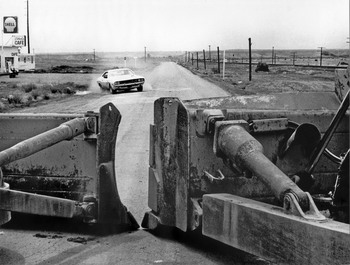 : still from "Vanishing Point" showing Ethel's Cafe on far left
: still from "Vanishing Point" showing Ethel's Cafe on far leftGerald Levern "Jerry"(1915 – 1971) and Ethel May Frazier(1925 – 2014) Spears married and resided at Cisco since 1962[5, 6]. Ethel was a cousin of Virginia Gruver. Jerry and Ethel opened up the Ethel's Cafe in 1965: beer license was granted to the two that year[7]. A 4000-gallon and a 2000-gallon underground steel tank provided the gasoline, and another 2000-gallon underground steel tank provided the diesel oil. Jerry hauled all the drinking water in Cisco from Thompson[8]. Ethel's nephew Jack Miller assisted them in pumping gas.
After the demise of Jerry, Ethel remarried Lawrence Walker "Shorty" Hale(1901 – 1980)[9]. Annual Financial Statement For the Year Ended December 31, 1974 shows her business as Ethel's Service[10]. Short stories about Ethel, her cafe, and her two years old male American Pitt Bull terrier in those days are found on the web[11, 12, 13, 14].
Larry Lee Sheets(1943 – 1999) purchased the business in 1977 and changed its name to Cisco Desert Sun Inn[15, 16]. Larry succeeded the cafe but not the gas service[17].
The hazardous waste incinerating company Cisco Development Inc., a subsidiary of CoWest Incineration Corp. of Denver backed by Catalyst Waste-to-Energy Corp., a subsidiary of Catalyst Energy Corp. of New York, took over the business in 1978.
Cisco Development Inc. called for the operator that February[18]. The company also acquired a beer license for use at its Cisco Store in April[19]. The cafe, the last surviving commercial space at Cisco at that time, was at least operating in 1978[20].
In 1979, the Desert Sun Inn was owned by Rose Irene Reed "Toni" Sanford(1943 − ?) of Gateway, CO and operated by her son Alfred Jr. Dean "Jock-o" Sanford(1965 − 2021)[21, 22]. Jock-o carried water from Fruita, CO. Unfortunately, however, no evidence of its survival has been found ever since.
Besides my own survey, I used Google Maps to draw plans of the structure. The result is shown below: of course, some imaginations are included.
revised, Jun. 13, 2017
revised, Feb. 4, 2018
revised, Jul. 31, 2021
revised, Sep. 23, 2022
revised, Apr. 16, 2023
[1] Apr. 30, 1936 Times Independent;
[2] Hepperle, Mary L. Cowger. "Memories of Cisco", Canyon Legacy, Vol. 51, Moab Museum, 2004;
[3] Sep. 14, 1978 Times Independent;
[4] Dec. 17, 1964 Times Independent;
[5] Dec. 6, 1962 Times Independent;
[6] May 13, 2014 Uintah Basin Standard;
[7] Mar. 11, 1965 Times Independent;
[8] arx. "Town of Cisco, part 3 – Rio Grande as a Lifeline", Boxcar Red Collection;
[9] Jun. 9, 1977 Times Independent;
[10] Feb. 6, 1975 Times-Independent;
[11] Oct. 14, 1976 Times Independent;
[12] Stile, Jim. "Poking Through the Ruins #7 ‘ETHELS’ CAFE’ in CISCO, UTAH’" Canyon County Zephyr, 2012;
[13] Gromer, Cliff. "Red Rocks, White Knuckles", Drag Racing, Volume VIII, Issue 3, 2006;
[14] Oct. 7, 1976 Times Independent;
[15] Oct. 20, 1977 Times Independent;
[16] Jan. 19, 1978 Times Independent;
[17] Dec. 17, 2009 Times Independent;
[18] Feb. 23, 1978 Times Independent;
[19] Apr. 6, 1978 Times Independent;
[20] Brown, Mike. A Conversation That Actually Just Happened, 2014;
[21] July 1, 1979 Daily Sentinel;
[22] July 1, 1979 Daily Sentinel;
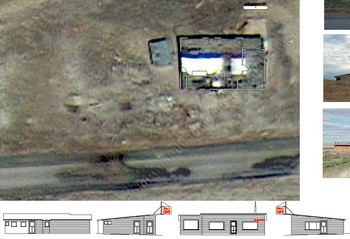 : references and the drawings of Ethel’s Cafe
: references and the drawings of Ethel’s Cafe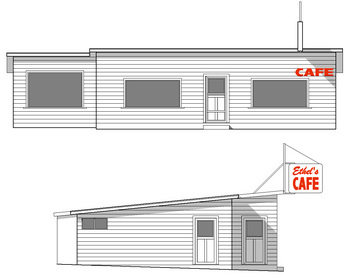 : north and east elevation of Ethel’s Cafe
: north and east elevation of Ethel’s Cafe2016-01-15 09:00
コメント(0)
D&RGW Telephone Booth (Outhouse) [Column_Cisco Townsite]
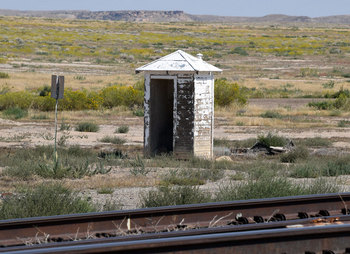 : Cisco, UT. Sep. 11, 2014
: Cisco, UT. Sep. 11, 2014I’m trying to duplicate the whole town of Cisco, Utah in N scale. This post introduces one of the structures in the town.
On the north side of Railroad Street/US Hwy 50 & 6 along the town of Cisco existed several railroad facilities constructed by the Denver & Rio Grande Western Railroad(D&RGW). One of the facilities, a telephone booth/outhouse still remains today.
A telephone booth is located a little apart from the railroad Section Tool House on the north. Today, it appears to be a tired outhouse with a vent cap sticking out of the roof: it was used as so by Geena Davis in the movie Thelma & Louise, which went on location at Cisco in August 1990.
But this is the genuine Rio Grande Telephone Booth built exactly to the Rio Grande Standard Plans first drawn in Jan. 1944[1].
According to ICC Valuation map, D&RGW originally didn't have any telephone booth at Cisco. The photo of Cisco townsite taken in 1969 also lacks the booth: it might have brought in from somewhere after that to use as an outhouse[2].
A similar structure is preserved at the nearby Western Mining and Railroad Museum at Helper, Utah. According to Trainorders.com post, this is a switchman’s shanty recovered from the switches at West Helper in the late 1980's[3].
I drew model plans referring to the Rio Grande Standard Plans. The result is shown below.
[1] Standard Telephone Booth, D&RGW Standard Plans;
[2] Jordan, Kathy ‘Uranium King’ Charlie Steen started out in Cisco tarpaper shack, Mar. 24, 2011 Grand Junction Daily Sentinel;
[3] Grandegold (2009) Trainorders Era Phone Booth at Gilluly, Trainorders.com;
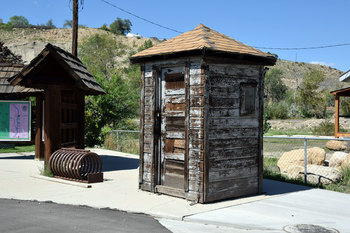 : Helper, UT. Sep. 10, 2014
: Helper, UT. Sep. 10, 2014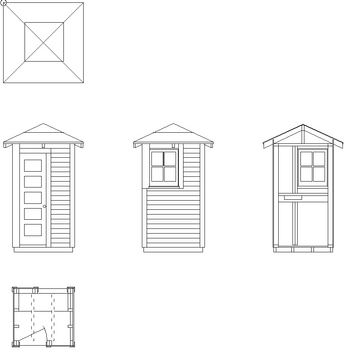 : model drawings for Rio Grande Telephone Booth
: model drawings for Rio Grande Telephone Booth2017-03-10 09:00
コメント(0)
Post Office [Column_Cisco Townsite]
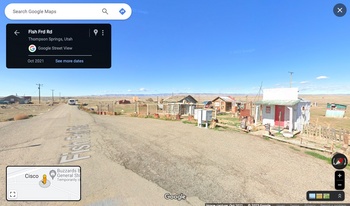
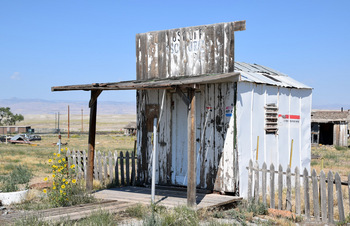 : Cisco, UT Sep. 11, 2014
: Cisco, UT Sep. 11, 2014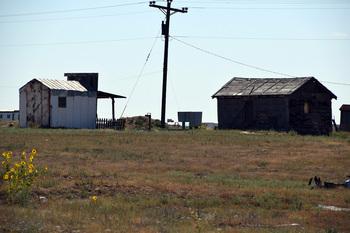 : Cisco, UT Sep. 11, 2014
: Cisco, UT Sep. 11, 2014I’m trying to duplicate the whole town of Cisco, Utah in N scale. This post introduces one of the structures in the town.
A few businesses survived along US Hwy 50 & 6 at Cisco in the early 70s; 4 gas service stations, a mercantile/cafe, and a motel. Some private houses also seem to exist along Second Street. This structure sits on Lot 12 of Block 8, Cisco Townsite.
Until May 1966, the Railway Post Office added to D&RGW Prospector consist served the region west from Grand Junction as far as Salt Lake City: all the RPO service contract at D&RGW was diverted to other modes on April 1, 1967[1, 2]. According to the ICC valuation map, the mail crane at Cisco station stood next to the depot on the west.
Not only mails addressed to Cisco, but mails to Castleton and Richardson were managed at Cisco: "celerity, certainly, and security (***)" Star Route contractors brought mails into both towns[3]. After the discontinuance of RPO service, Star Route contractor buses, trucks, and air taxis based at Moab succeeded the contract at Cisco[4]. Today, mails are carried from Green River.
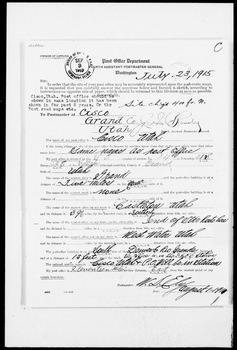 : 1915 Report of Site Location for Cisco Post Office
: 1915 Report of Site Location for Cisco Post OfficeThe original Cisco Post Office at the narrow gauge railroad watering station was granted in 1887[5]. The initial object of the Cisco P.O. was to handle mail to/from Richardson P.O. It was moved along with the depot by July 1890. It was located in the depot until the P.O./Store combination facilities were erected next to the Cisco Hotel on Block 6 in the 1910s between 1915 and 1919.
In 1923, the post office structure, a combination post office/postmaster’s dwelling at that time, was moved one block west to Lot 12 of Block 5, next to the Cisco Mercantile. The "Federal Building" was repainted dark red with white trimming[6, 7].
The post office −exactly, only the postal cabinet− was moved again a mile west into Harris' service station when Wava Harris succeeded the postmistress in 1959[8]. Zip Code 84515 was assigned in 1963. However, unfortunately, the post office was once discontinued when Wava resigned in 1967: the postal function moved temporally into Cisco Mercantile after that[9, 10, 11]. In the movie Vanishing Point, upraised Stars and Stripes and a small OFFICE sign above the door clearly show the post office is in the mercantile.
The latest post office structure shown above at Second Street seems to have been installed by 1971: Cisco Mercantile closed its doors that year. The postal service at this office survived well into the 21st Century. The structure itself is living on borrowed time[12].
 : 1928 Cisco postmark
: 1928 Cisco postmarkJohn Samuel Martin(1852 – 1918), a surveyor of the Denver & Rio Grande Western Railway, was the original postmaster since Mar. 10, 1887[5].
According to the Postmaster Appointments for Grand County, Utah, Richard C. Camp(1846 – 1923) was the second postmaster since Dec. 5, 1889.
John H. Miller was the first postmaster at the new townsite inside the railroad depot since Oct. 10, 1890.
Successive railroad agents must have held the postmasters at once (* shows the confirmed interlocking agent)[13]. Pardon H. Jeffers*(1846 – 1937) was the postmaster since 1895, Alfred B. Bush since 1898, Horace J. Cooper(1868 – 1939)* since 1899, Robert A. Greene*(1868 – 1922) since 1900, Henry T. Matthews* since 1901, Oakley M. Bailey since 1903, Sherman Bowen*(1876 – 1938) since 1905, Charles R. Cahill since Jan. 1907, Charles A. Pierson since Jul. 1907, Nathan E. Reynolds*(1879 – 1939) since Jan. 1908, Albert L. Hanson(1881 – 1977) since Jul. 1908, James I. Rounds*(1865 – 1945) since 1910, and Willis D. Ely*(1886 – 1965) since 1915.
Henry Hansen(1860 – 1932) had been appointed the postmaster since 1919 and for more than a decade into the 30s[14, 15]. However, unfortunately, Henry passed away on Dec. 1st, 1932. Thus, Luciel Quiett acted for Henry in Jan. 1933.
Henrietta Marie "Hattie" Fuller(1888 – 1969) was the postmistress from Feb. 1933 and well into the 50s. In 1958, Albert R. Myers succeeded Fuller.
Wava Frances Harris(1917 – 1969), the spouse of the highway foreman Ballard Harris, had been appointed to the postmistress in 1959 and was on duty for eight years[5]. The original postal cabinet made of oak was relocated into Harris' gas station a mile west of the town[8]. Upon the retirement of Wava, she and Ballard moved the postal cabinet to Dewey and displayed it in their gas service station for the next forty years. Today, the cabinet is at Coleman House B&B in Harrodsburg, Kentucky[10]. A photo of Ballard with the cabinet is found on the web[16].
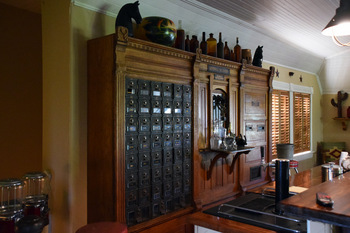
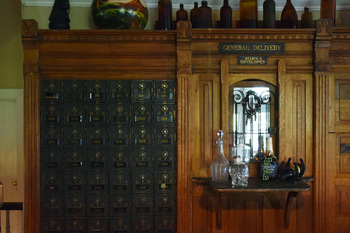 : Harrodsburg, KY. Sep. 9, 2019
: Harrodsburg, KY. Sep. 9, 2019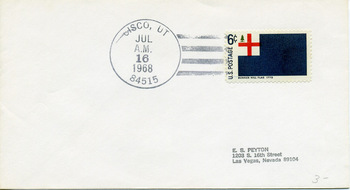 : 1968 Cisco postmark
: 1968 Cisco postmarkThereafter, the post office was operated as a branch of the Green River Post Office. Beulah Rose Campbell(1907 – 1971) of Thompson was taking care of the mail in 1969[17]. Helen LaVita Bylerly Walker(1906 – 1979) of Cisco Mercantile was the postmistress in 1971[4]. Raymond Scott(1908 – 1989) of Cisco Automotive Service was the postmaster in the 70s at least until 1976[18]. Sharon Francine Dalgleish(1947 – ) was the postmistress at least in 1979[19].
Paula Dee Raney(1947 – 2010) was the postmistress in the early 90s[20]. Sharon Dalgleish was again the postmistress maybe since 1992[21, 22]. Sharon finally closed the post office no later than 2010.
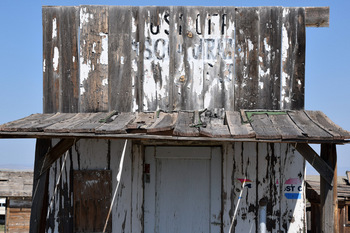 : Cisco, UT Sep. 11, 2014
: Cisco, UT Sep. 11, 2014In 2003, Wim Wenders, the Paris, Texas movie director, took a photo of the post office during the location at Cisco for his movie Don’t Come Knocking[23]. The movie below shows the interior of the post office in 2009. The full eagle logo of the United States Postal Service, used between 1970 and 1993, barely shows what this shack was today. Letters barely read on the façade are;
U.S. POST OFFICE
CISCO, UTAH
EL4370 84515
revised, Nov. 3, 2018
revised, Mar. 30, 2019
revised, Aug. 3, 2021
revised, Jan. 8, 2022
revised, Jun. 3, 2022
revised, Dec. 28, 2022
revised, Mar. 16, 2023
revised, Nov. 10, 2023
[1] Denver and Rio Grande Western Railroad Company, Annual Report 1967
[2] Strack, Don “D&RGW Prospector and Royal Gorge”, UTAHRAILS.NET;
[3] Jun. 17, 1954 Times-Independent;
[4] Apr. 29, 1971 Daily Sentinel;
[5] Postmasters Appointment for Emery County, Utah Territory;
[6] Herman Grell Giodwad(#8000-11545), Investigative Case Files of the Bureau of Investigation 1908 - 1922;
[7] May 24, 1923 Times-Independent;
[8] Oct. 25, 1959 Daily Sentinel;
[9] Mar. 6, 1969 Times-Independent;
[10] Coleman House B&B web page;
[11] Jul. 27, 1969 Daily Sentinel;
[12] May 6, 1971 Times-Independent;
[13] May 16, 1913 Grand Valley Times;
[14] Feb. 14, 1919 Times-Independent;
[15] Dec. 8, 1932 Times-Independent;
[16] Repko, Sue (2002) “H. Ballard Harris”;
[17] Dec. 11, 1969 Times-Independent;
[18] Apr. 1, 1976 Times-Independent;
[19] Jul. 1, 1979 Daily Sentinel;
[20] Jun. 30, 2010 The Daily Sentinel;
[21] Jackson, Jen (2010) “The Madness and Memories of Cisco, Utah”, Inside Outside Southwest Magazine;
[22] JR4X (2008) “Cisco-Home of The Hills Have Eyes?”, Bulletin Board, Colorado4x4.org;
[23] Wenders, Wim (2003) “Cisco Post office”;
: post office interior
2017-03-24 09:00
コメント(0)
School [Column_Cisco Townsite]
: site of school in the distance
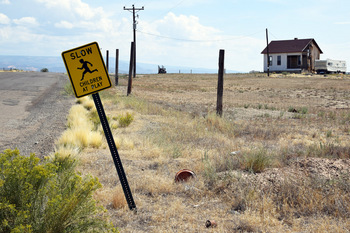 : Cisco, UT Sep. 10, 2017
: Cisco, UT Sep. 10, 2017
I’m trying to duplicate the whole town of Cisco, Utah in N scale. This post introduces one of the structures in the town.
A few businesses survived along US Hwy 50 & 6 at Cisco in the early 70s; 4 gas service stations, a mercantile/cafe, and a motel. Some private houses also seem to exist along Second Street. The southernmost of the town sat this structure on Lots 17, 18, 19, and 20 of Block 22, Cisco Townsite.
The school at Cisco was established in 1898[1]. Victor Putman Hanson(1841 – 1920) offered the schoolhouse. May Jones was the original teacher and there were sixteen pupils. The school bell rang at nine o’clock in the evening to inform the children of the curfew[2]. Any photos of the original schoolhouse aren't found, but a part of Maynard House is said to be the original schoolhouse[3].
In 1919, the “barest makeshift tie shack” used as the schoolhouse was sold and the town had to find a replacement[4]. Accordingly, a new 16'×24' schoolhouse was constructed by the contractor V. R. Bush, on Main Street up the hill south of the town, only in two weeks[5, 6]. The lots were offered by Richard M Handy[7]. The 17'×20' Fruita, Utah schoolhouse built in 1896 shown below may provide some information about the heyday of Cisco School.
Giant stride swing, volleyball, and net were added to school equipment in 1928[8]. Unfortunately, however, the school was temporally closed between 1943 and 1944 due to the lack of pupils: the enrollments in those years were nine[9, 10].
Edwinna McFarland(1883 – 1964) taught for nine years since 1945 after the temporary closure. William Cowger(1889 – 1971) of the Cisco Mercantile provided power from his private generating plant since 1951[11]. The piano was tuned and the blackboard was renewed in 1953[12]. Victor Murray(1893 – 1962) provided natural gas free of cost from his gas well to the school to fire an automatic thermostat-controlled heating unit in 1954[13]. Pupils enjoyed the Sylvania Hi-Fi machine newly arranged in 1958[14].
Unfortunately, however, the school was closed again in 1959 due to the lack of pupils[15]. Mary Eleanor Gould(1895 – 1973), sister of Edwinna, was the last teacher. Number of the last pupils was fourteen[16]. The school board seat assigned by Grand County Commission to Cisco was eliminated in 1961[17].
Two Oil Companies, Promontory Oil and Federal Oil, rented the vacant schoolhouse structure for storage in 1964[18]. We can see it in the 1969 photo attached to Kathy Jordan’s articles[19]. The structure also appears in the movie Vanishing Point shot in 1970. The structure was finally demolished maybe in the 70s, no later than 1974, according to USGS aerial photos.
Accommodation for the successive teachers was provided by Victor Murray near the schoolhouse on Lots 22, 23, and 24 of Block 11 at the corner of Second Street and Colorado Street. It was built by Pace Brothers in the 20s[20, 21]. This structure still survives to this day.
[1] Dec. 23, 1898 Grand Valley Times;
[2] Sep. 8, 1905 Grand Valley Times;
[3] Dalton, Vonna Foy. “Some Remembrances of Picture Gallery and Cisco”, #51, Canyon Regacy, Moab Museum, 2004;
[4] Oct. 16, 1919 Times Independent
[5] Oct. 23, 1919 Times Independent;
[6] Nov. 6, 1919 Times Independent;
[7] Feb. 2, 1918 Grand Valley Times;
[8] May 3, 1928 Times Independent;
[9] Aug. 26, 1943 Times Independent;
[10] Aug. 30, 1945 Times Independent;
[11] Mar. 8, 1951 Times Independent;
[12] Oct. 15, 1953 Times-Independent;
[13] Oct. 7, 1954 Times Independent;
[14] Jan. 30, 1958 Times Independent;
[15] Aug. 13, 1959 Times Independent;
[16] Sep. 12, 1958 Times Independent;
[17] May 4, 1961 Times Independent;
[18] Sep. 3, 1964 Times Independent;
[19] Jordan, Kathy "‘Uranium King’ Charlie Steen started out in Cisco tar¬paper shack", Mar. 24, 2011 Daily Sentinel;
[20] description on the flooring;
[21] description "teacher Dorothy Miller, boarder of Annie M. Pace" in the 1930 Census
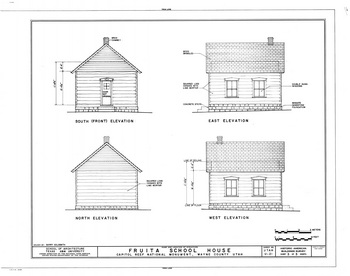 : drawings of Fruita schoolhouse
: drawings of Fruita schoolhouse
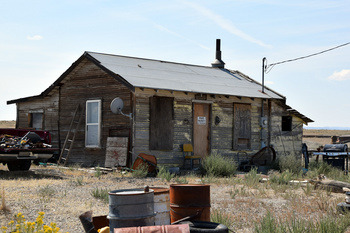 : teacher's house
: teacher's house
 : Cisco, UT Sep. 10, 2017
: Cisco, UT Sep. 10, 2017I’m trying to duplicate the whole town of Cisco, Utah in N scale. This post introduces one of the structures in the town.
A few businesses survived along US Hwy 50 & 6 at Cisco in the early 70s; 4 gas service stations, a mercantile/cafe, and a motel. Some private houses also seem to exist along Second Street. The southernmost of the town sat this structure on Lots 17, 18, 19, and 20 of Block 22, Cisco Townsite.
The school at Cisco was established in 1898[1]. Victor Putman Hanson(1841 – 1920) offered the schoolhouse. May Jones was the original teacher and there were sixteen pupils. The school bell rang at nine o’clock in the evening to inform the children of the curfew[2]. Any photos of the original schoolhouse aren't found, but a part of Maynard House is said to be the original schoolhouse[3].
In 1919, the “barest makeshift tie shack” used as the schoolhouse was sold and the town had to find a replacement[4]. Accordingly, a new 16'×24' schoolhouse was constructed by the contractor V. R. Bush, on Main Street up the hill south of the town, only in two weeks[5, 6]. The lots were offered by Richard M Handy[7]. The 17'×20' Fruita, Utah schoolhouse built in 1896 shown below may provide some information about the heyday of Cisco School.
Giant stride swing, volleyball, and net were added to school equipment in 1928[8]. Unfortunately, however, the school was temporally closed between 1943 and 1944 due to the lack of pupils: the enrollments in those years were nine[9, 10].
Edwinna McFarland(1883 – 1964) taught for nine years since 1945 after the temporary closure. William Cowger(1889 – 1971) of the Cisco Mercantile provided power from his private generating plant since 1951[11]. The piano was tuned and the blackboard was renewed in 1953[12]. Victor Murray(1893 – 1962) provided natural gas free of cost from his gas well to the school to fire an automatic thermostat-controlled heating unit in 1954[13]. Pupils enjoyed the Sylvania Hi-Fi machine newly arranged in 1958[14].
Unfortunately, however, the school was closed again in 1959 due to the lack of pupils[15]. Mary Eleanor Gould(1895 – 1973), sister of Edwinna, was the last teacher. Number of the last pupils was fourteen[16]. The school board seat assigned by Grand County Commission to Cisco was eliminated in 1961[17].
Two Oil Companies, Promontory Oil and Federal Oil, rented the vacant schoolhouse structure for storage in 1964[18]. We can see it in the 1969 photo attached to Kathy Jordan’s articles[19]. The structure also appears in the movie Vanishing Point shot in 1970. The structure was finally demolished maybe in the 70s, no later than 1974, according to USGS aerial photos.
Accommodation for the successive teachers was provided by Victor Murray near the schoolhouse on Lots 22, 23, and 24 of Block 11 at the corner of Second Street and Colorado Street. It was built by Pace Brothers in the 20s[20, 21]. This structure still survives to this day.
revised, Nov. 15, 2017
revised, Feb. 6, 2018
revised, Apr. 7, 2023
[1] Dec. 23, 1898 Grand Valley Times;
[2] Sep. 8, 1905 Grand Valley Times;
[3] Dalton, Vonna Foy. “Some Remembrances of Picture Gallery and Cisco”, #51, Canyon Regacy, Moab Museum, 2004;
[4] Oct. 16, 1919 Times Independent
[5] Oct. 23, 1919 Times Independent;
[6] Nov. 6, 1919 Times Independent;
[7] Feb. 2, 1918 Grand Valley Times;
[8] May 3, 1928 Times Independent;
[9] Aug. 26, 1943 Times Independent;
[10] Aug. 30, 1945 Times Independent;
[11] Mar. 8, 1951 Times Independent;
[12] Oct. 15, 1953 Times-Independent;
[13] Oct. 7, 1954 Times Independent;
[14] Jan. 30, 1958 Times Independent;
[15] Aug. 13, 1959 Times Independent;
[16] Sep. 12, 1958 Times Independent;
[17] May 4, 1961 Times Independent;
[18] Sep. 3, 1964 Times Independent;
[19] Jordan, Kathy "‘Uranium King’ Charlie Steen started out in Cisco tar¬paper shack", Mar. 24, 2011 Daily Sentinel;
[20] description on the flooring;
[21] description "teacher Dorothy Miller, boarder of Annie M. Pace" in the 1930 Census
 : drawings of Fruita schoolhouse
: drawings of Fruita schoolhouse : teacher's house
: teacher's house2017-09-29 09:00
コメント(0)
Seely House (Signal Maintainer’s House) [Column_Cisco Townsite]
: site of Seely House
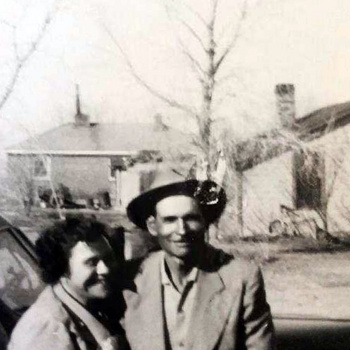 : Seely House in the backgorund, Lucilo and Marie Aguilera in the foreground. courtesy of AJ Rogers, Manuel Aguilera
: Seely House in the backgorund, Lucilo and Marie Aguilera in the foreground. courtesy of AJ Rogers, Manuel Aguilera
I’m trying to duplicate the whole town of Cisco, Utah in N scale. This post introduces one of the structures in the town.
On the north side of Railroad Street/US Hwy 50 & 6 along the town of Cisco existed several railroad facilities constructed by the Denver & Rio Grande Western Railroad(D&RGW). One of the facilities, a signal maintainer's house is identified in the 1971 movie Vanishing Point. The west elevation of the structure is barely seen in the movie.
1952 USGS aerial photo shows the particular structure. The same structure appears in a map attached to the Cisco Gravity Base Station sheet, researched in 1967 and printed in 1971, as RED BRICK HOUSE[1]. The same structure appears in a map representing Cisco in the late 40s as Seely Red Brick House[2]. ICC valuation map drawn in 1919 and revised in 1949 measures this structure as 25'×44'.
CTC(Centralized Traffic Control) system of D&RGW reached Cisco in 1944[3]. This structure was constructed the same year[4]. William J. Hawley Seely(1916 – 2001), who was a D&RGW signal maintainer assigned at Green River since 1943, moved to Cisco same year[5,6]. At that time when J. Hawley, his spouse Carolyn Sarah Beebe(1913 – 1985), and their son George James(1939 – ?) moved to Cisco, the construction of house wasn't started yet, forced the family to live in an outfit car[7]. Daughter Susan Jane "Sue"(1945 – ) was born shortly after they moved to Cisco[8].
While Hawley worked for the railroad, Carolyn contributed to the community as School Board and Justice of Peace: she also ran a Red Cross First Aid station at the house and regularly checked the Cisco’s drinking water brought in by a tank car[7].
James Monroe Noblitt Jr.(1926 – 2000) of Green River succeeded Seely in 1958[9]. His father James Monroe Noblitt Sr.(1892 – 1967) was the D&RGW section foreman at Cisco and retired same year[10]. But James Jr. and his spouse Betty Lou(1926 – 2013) kept living in their house at Green River[11].
In 1960, successor Noblitt Jr. was transferred to Helper, Utah due to the Signal Department reorganization: the whole district between Ogden, UT, and Dotsero, CO, came to be controlled from Helper since that year[4, 12]. That was also the last use of this house. But the house itself survived into the 70s, at least until June 1974 according to the USGS aerial photo.
[1] Cook, Kenneth L. (1971) Gravity base station network in Utah, #92, Utah Geological and Mineralogical Survey Bulletin
[2] Hepperle, Mary L. (2004) "Memories of Cisco", Canyon Legacy, vol. 51, Moab Museum;
[3] Sep. 8, 1955 Green River Journal;
[4] Mar. 31, 1944 Daily Sentinel;
[5] Apr. 1, 1943 Times Independent;
[6] Jan. 21, 1944 Emery County Progress;
[7] Jordan, Kathy "‘Uranium King’ Charlie Steen started out in Cisco tar-paper shack", Mar. 24, 2011 Daily Sentinel
[8] May 8, 2018 Daily Sentinel;
[9] Feb. 6, 1958 Times Independent;
[10] Apr. 13, 1967 Times Independent;
[11] Feb. 27, 1958 Times Independent;
[12] Aug. 25, 1960 Times Independent;
 : Seely House in the backgorund, Lucilo and Marie Aguilera in the foreground. courtesy of AJ Rogers, Manuel Aguilera
: Seely House in the backgorund, Lucilo and Marie Aguilera in the foreground. courtesy of AJ Rogers, Manuel AguileraI’m trying to duplicate the whole town of Cisco, Utah in N scale. This post introduces one of the structures in the town.
On the north side of Railroad Street/US Hwy 50 & 6 along the town of Cisco existed several railroad facilities constructed by the Denver & Rio Grande Western Railroad(D&RGW). One of the facilities, a signal maintainer's house is identified in the 1971 movie Vanishing Point. The west elevation of the structure is barely seen in the movie.
1952 USGS aerial photo shows the particular structure. The same structure appears in a map attached to the Cisco Gravity Base Station sheet, researched in 1967 and printed in 1971, as RED BRICK HOUSE[1]. The same structure appears in a map representing Cisco in the late 40s as Seely Red Brick House[2]. ICC valuation map drawn in 1919 and revised in 1949 measures this structure as 25'×44'.
CTC(Centralized Traffic Control) system of D&RGW reached Cisco in 1944[3]. This structure was constructed the same year[4]. William J. Hawley Seely(1916 – 2001), who was a D&RGW signal maintainer assigned at Green River since 1943, moved to Cisco same year[5,6]. At that time when J. Hawley, his spouse Carolyn Sarah Beebe(1913 – 1985), and their son George James(1939 – ?) moved to Cisco, the construction of house wasn't started yet, forced the family to live in an outfit car[7]. Daughter Susan Jane "Sue"(1945 – ) was born shortly after they moved to Cisco[8].
While Hawley worked for the railroad, Carolyn contributed to the community as School Board and Justice of Peace: she also ran a Red Cross First Aid station at the house and regularly checked the Cisco’s drinking water brought in by a tank car[7].
James Monroe Noblitt Jr.(1926 – 2000) of Green River succeeded Seely in 1958[9]. His father James Monroe Noblitt Sr.(1892 – 1967) was the D&RGW section foreman at Cisco and retired same year[10]. But James Jr. and his spouse Betty Lou(1926 – 2013) kept living in their house at Green River[11].
In 1960, successor Noblitt Jr. was transferred to Helper, Utah due to the Signal Department reorganization: the whole district between Ogden, UT, and Dotsero, CO, came to be controlled from Helper since that year[4, 12]. That was also the last use of this house. But the house itself survived into the 70s, at least until June 1974 according to the USGS aerial photo.
revised, Aug. 5, 2021
revised, Apr. 18, 2023
[1] Cook, Kenneth L. (1971) Gravity base station network in Utah, #92, Utah Geological and Mineralogical Survey Bulletin
[2] Hepperle, Mary L. (2004) "Memories of Cisco", Canyon Legacy, vol. 51, Moab Museum;
[3] Sep. 8, 1955 Green River Journal;
[4] Mar. 31, 1944 Daily Sentinel;
[5] Apr. 1, 1943 Times Independent;
[6] Jan. 21, 1944 Emery County Progress;
[7] Jordan, Kathy "‘Uranium King’ Charlie Steen started out in Cisco tar-paper shack", Mar. 24, 2011 Daily Sentinel
[8] May 8, 2018 Daily Sentinel;
[9] Feb. 6, 1958 Times Independent;
[10] Apr. 13, 1967 Times Independent;
[11] Feb. 27, 1958 Times Independent;
[12] Aug. 25, 1960 Times Independent;
2018-08-03 09:00
コメント(0)



